Fairy tale from a thousand and one nights including desert feeling…
With a photo journey through the Rub al-Khali, the largest sand desert on earth. Besides the desert adventure, we roam through an impressive world of diversity as well as a multifaceted architecture in Oman, in the south of the Arabian Peninsula. With me in the luggage, my Fuji GFX100.
From time to time, I think about how to keep my photographic equipment up to date with the latest technology – and this was also the case in the summer of 2020. Do I exchange my camera bodies for new models, or do I go for a system change? After a test weekend with the Fuji GFX100, the decision was quickly made, albeit with a heavy heart. The following fall, I sold all my 35mm photo equipment and switched to the GFX100.
However, after an initial phase of getting acquainted with the new menu structures, color scheme, etc., I was missing an impressive landscape to max out the camera. This landscape was still to come with the COVID events. I used the time to get to grips more intensively with the menus and peculiarities of the GFX100. Likewise, to complete my lens palette bit by bit.
Finally, on February 12th, 2022, our group (a photography trip) gathered at the airport in Muscat, the capital of Oman. Besides the Arabian culture from ‘One Thousand and One Nights’, the Rub al-Khali was the main focus of our photo trip.
After a short gathering phase at the hotel, we make our way to the Royal Opera House, towards evening we photograph ‘at’ the Great Sultan Qaboos Mosque and the traditional souk – the market.
The next morning it is time to fully equip the vehicles: two Toyota Land Cruisers, with additional gasoline and water tanks, sand plates, recovery belts, etc. After a morning shoot ‘in’ the Great Sultan Qaboos Mosque, we leave the coastal area and cross the Hajar Mountains on the gravel roads of the Wadi Bani Awf (mountain pass, about 2,100 m above sea level).
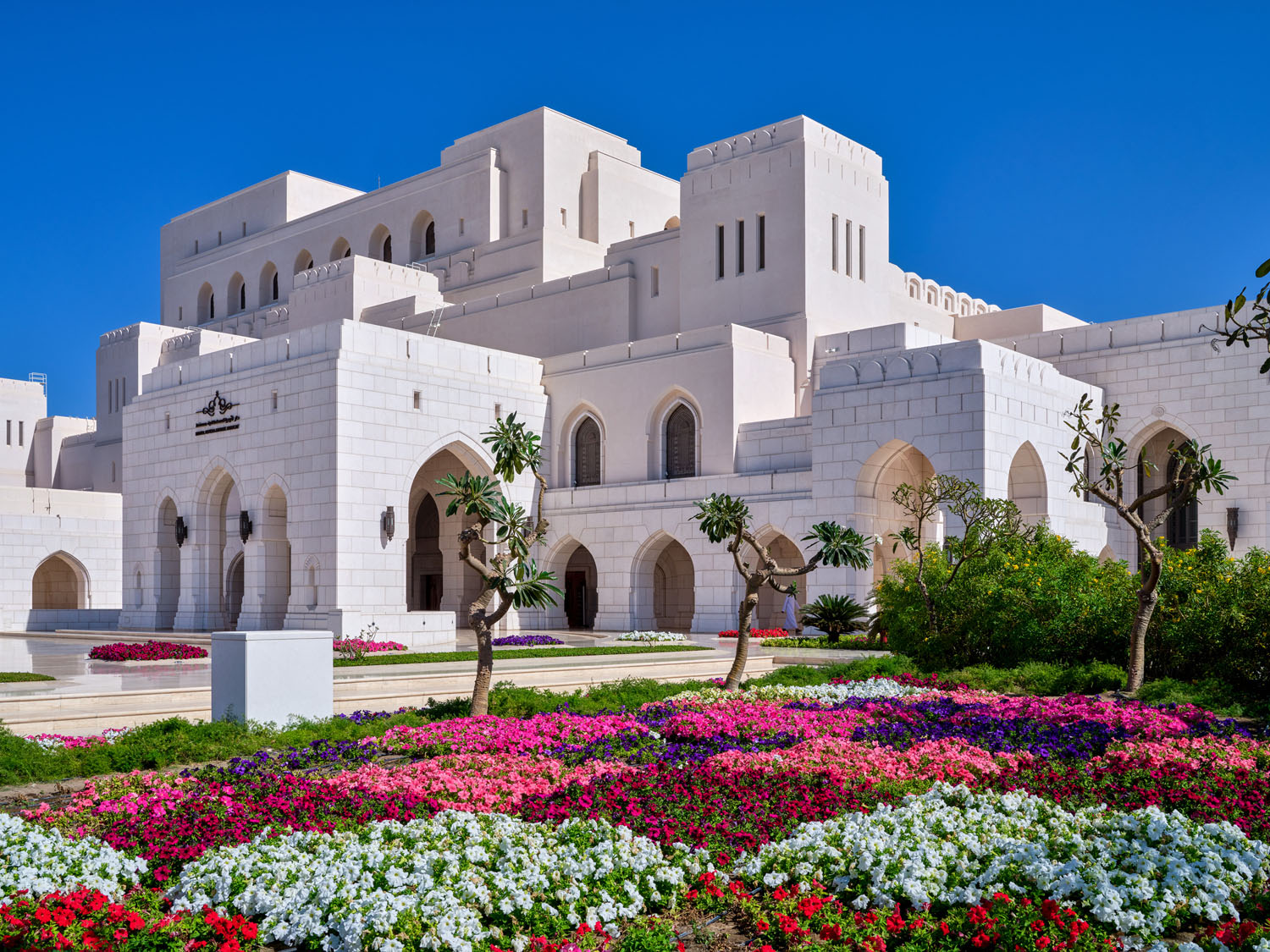
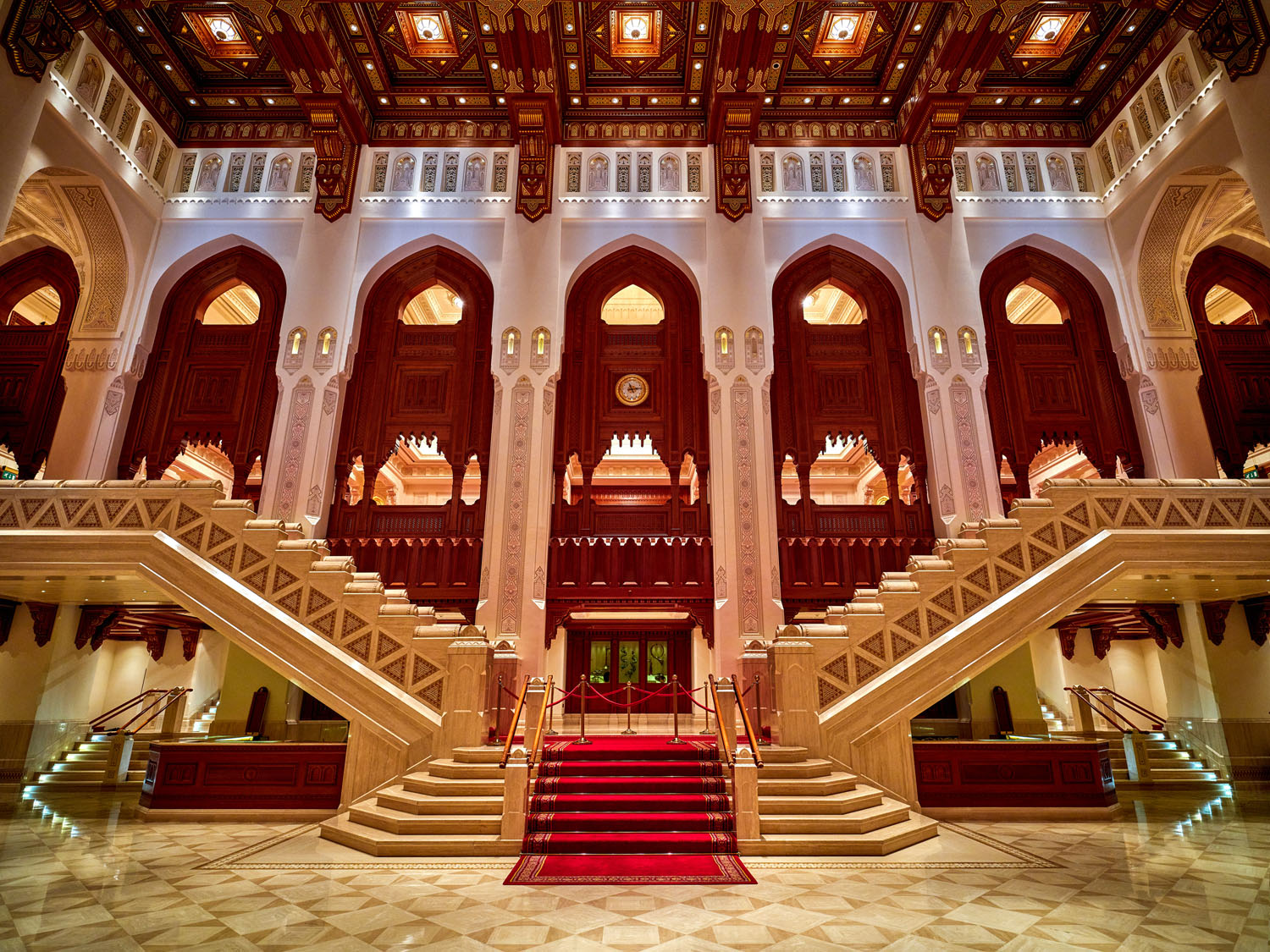
At the Royal Opera House in the capital Masakt
RIGHT: Fuji GFX 100 . Fuji GF23mmF4 . f/4.5 . 1/80″ . ISO 1.600 . WB 2.250 K . hand-held
In the foyer of the Royal Opera House
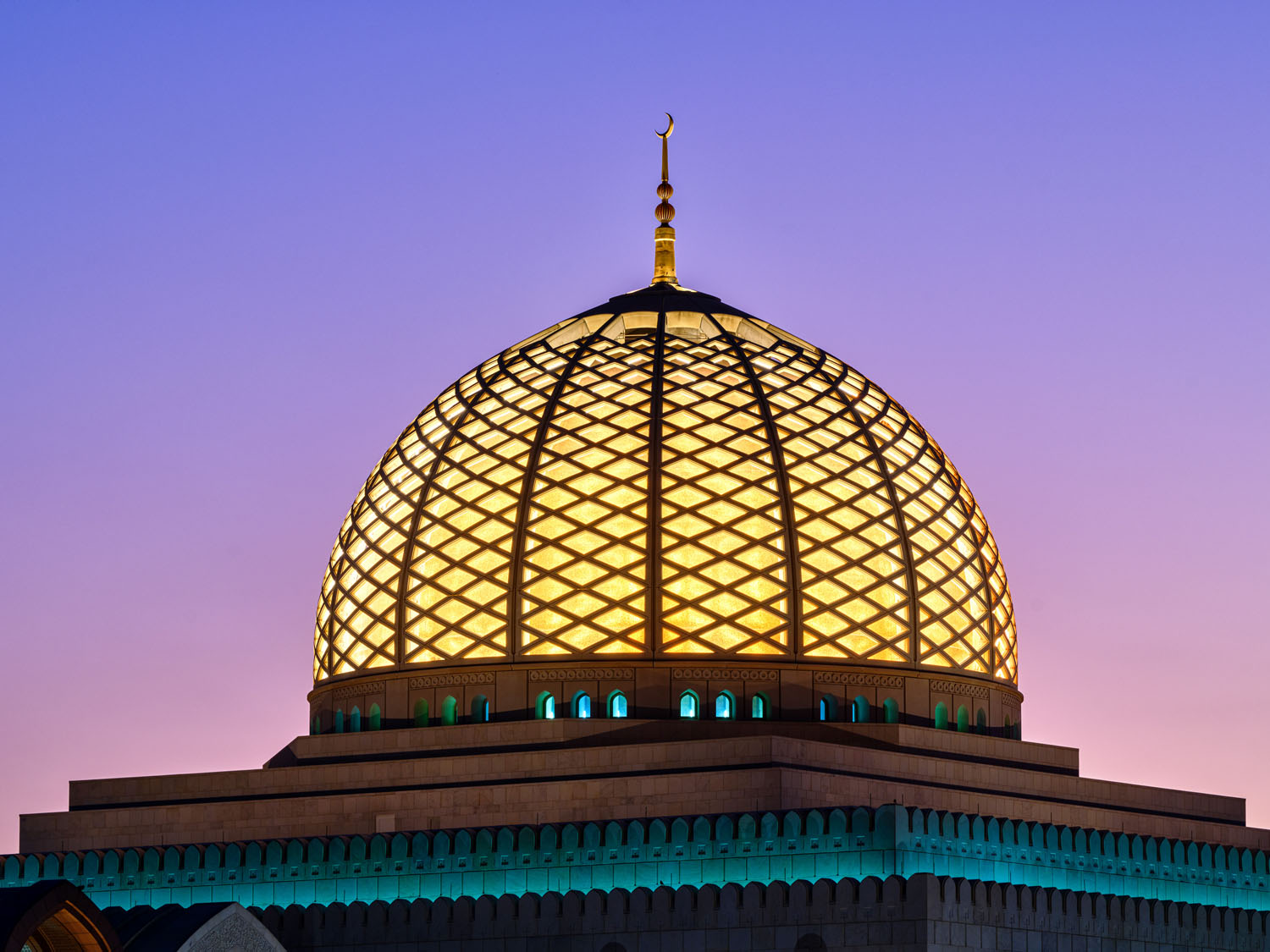
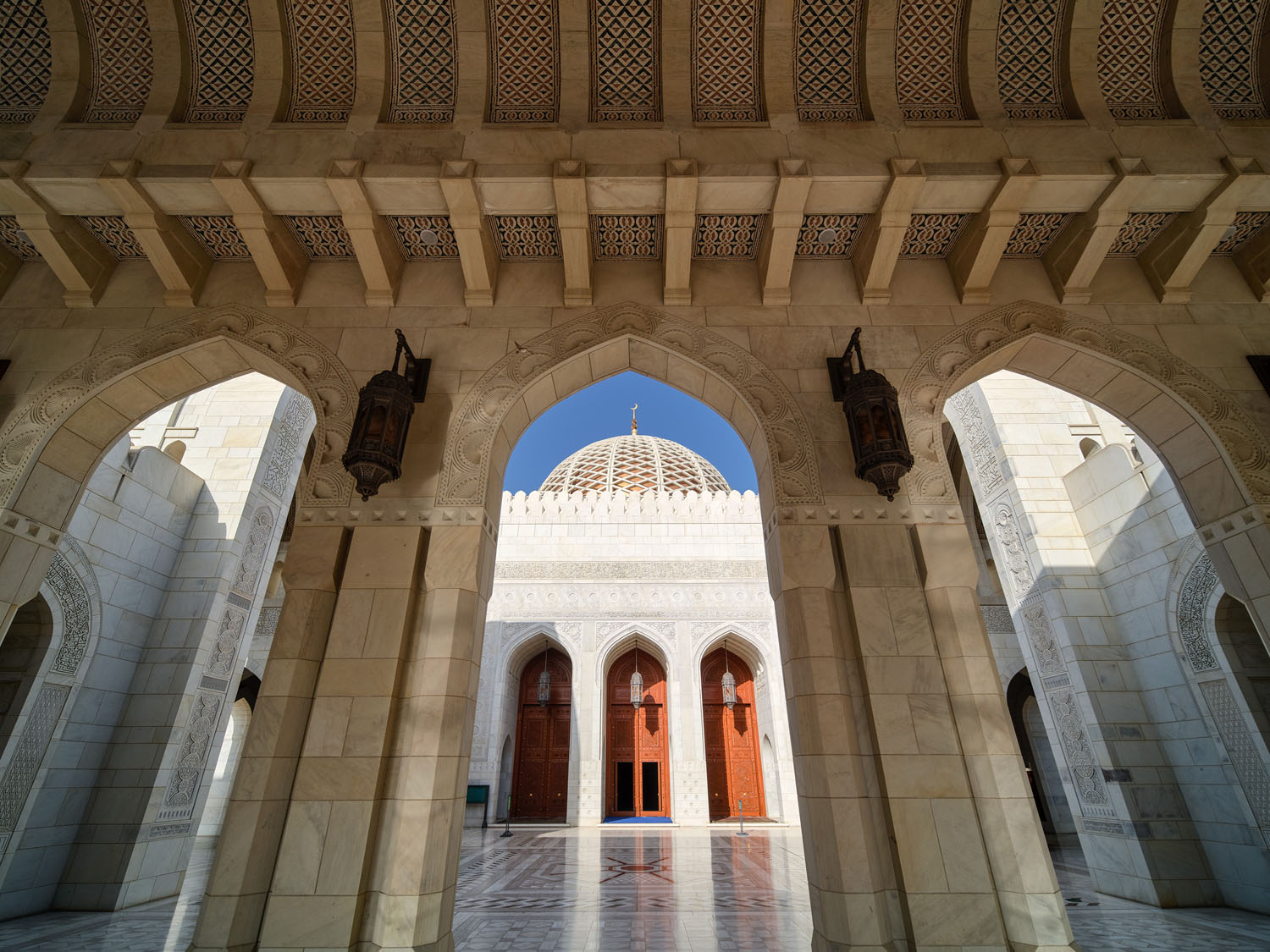
The central dome of the Great Sultan Qaboos Mosque rises 50 meters high into the dusk
RIGHT: Fuji GFX 100 . Laowa 17mmF1.8 . f/16 . 1/320″ . ISO 250 . WB 4.250 K | hand-held
A view between the riwaq (archways) to the entrance as well as the central dome of the Great Sultan Qaboos Mosque
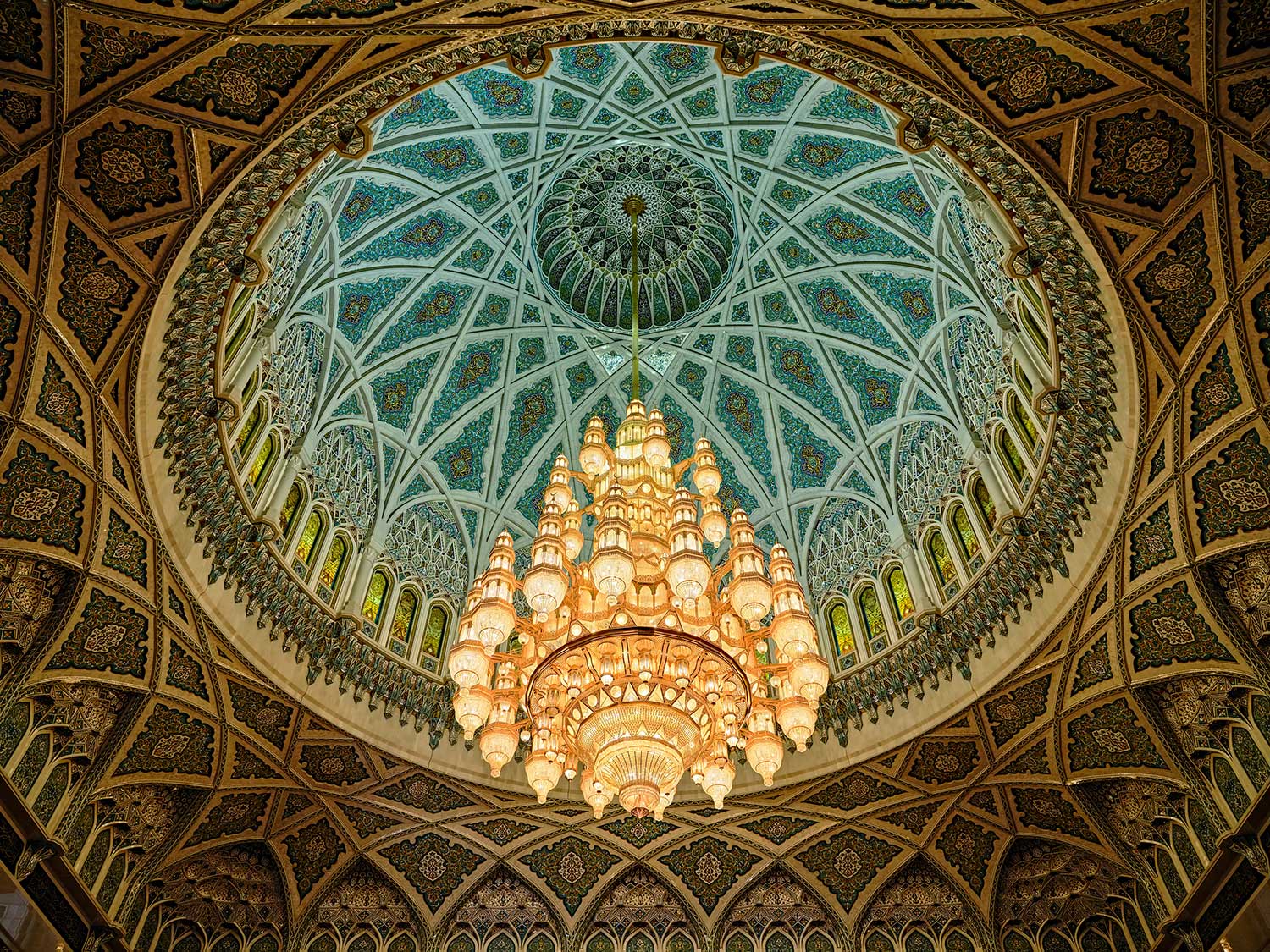
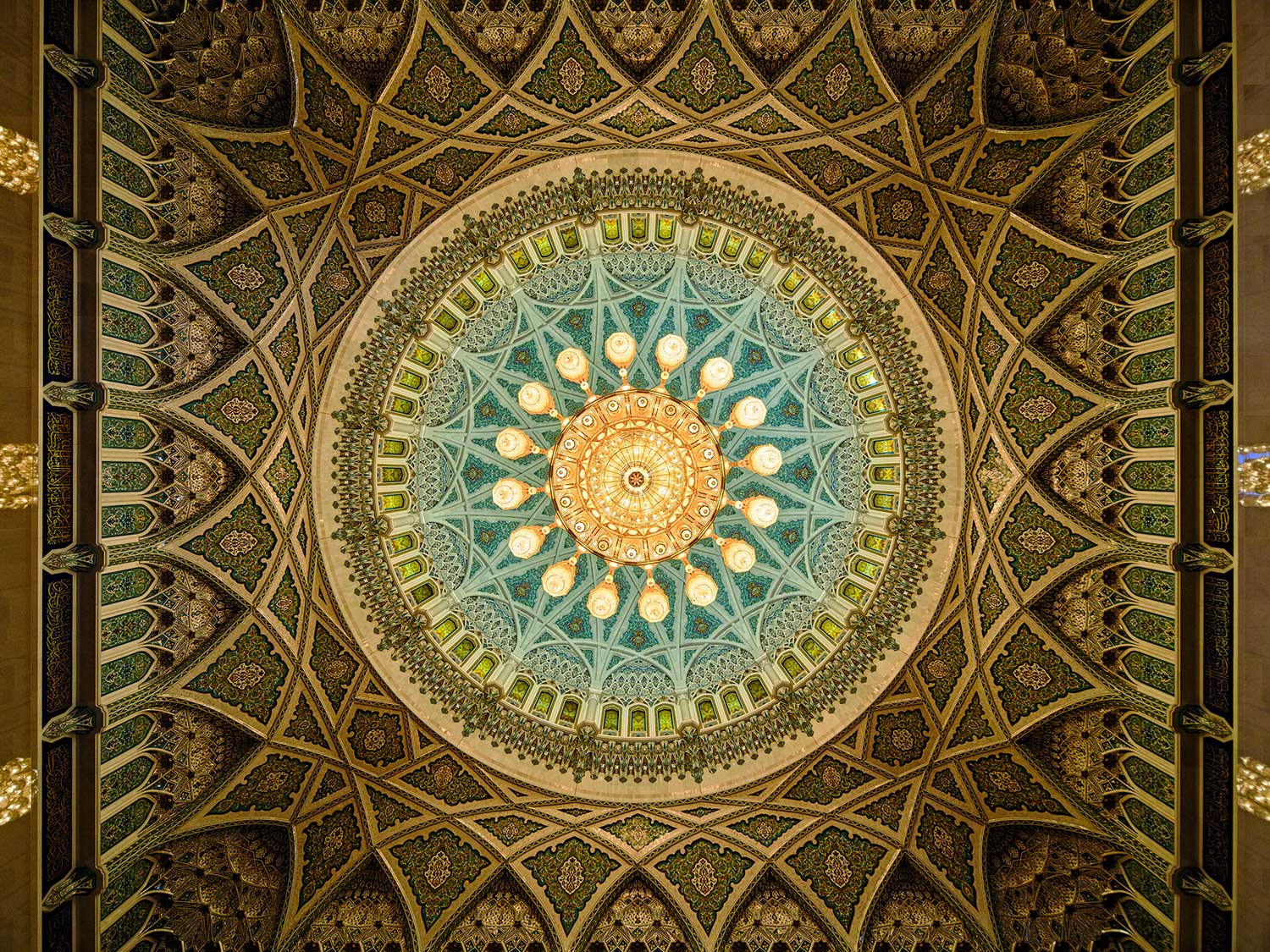
The chandelier in the large men’s prayer hall. It weighs a stately eight tons and measures eight by fourteen meters. A total of 1,122 bulbs illuminate the numerous Swarovski crystals
RIGHT: Fuji GFX 100 . Laowa 17mmF1.8 . f/8 . 1/100″ . ISO 640 . WB 3.580 K . hand-held
The perfect shooting position to stage the chandelier with the dome is ‘directly’ in the center under the chandelier. However, its majestic dimension now disappears
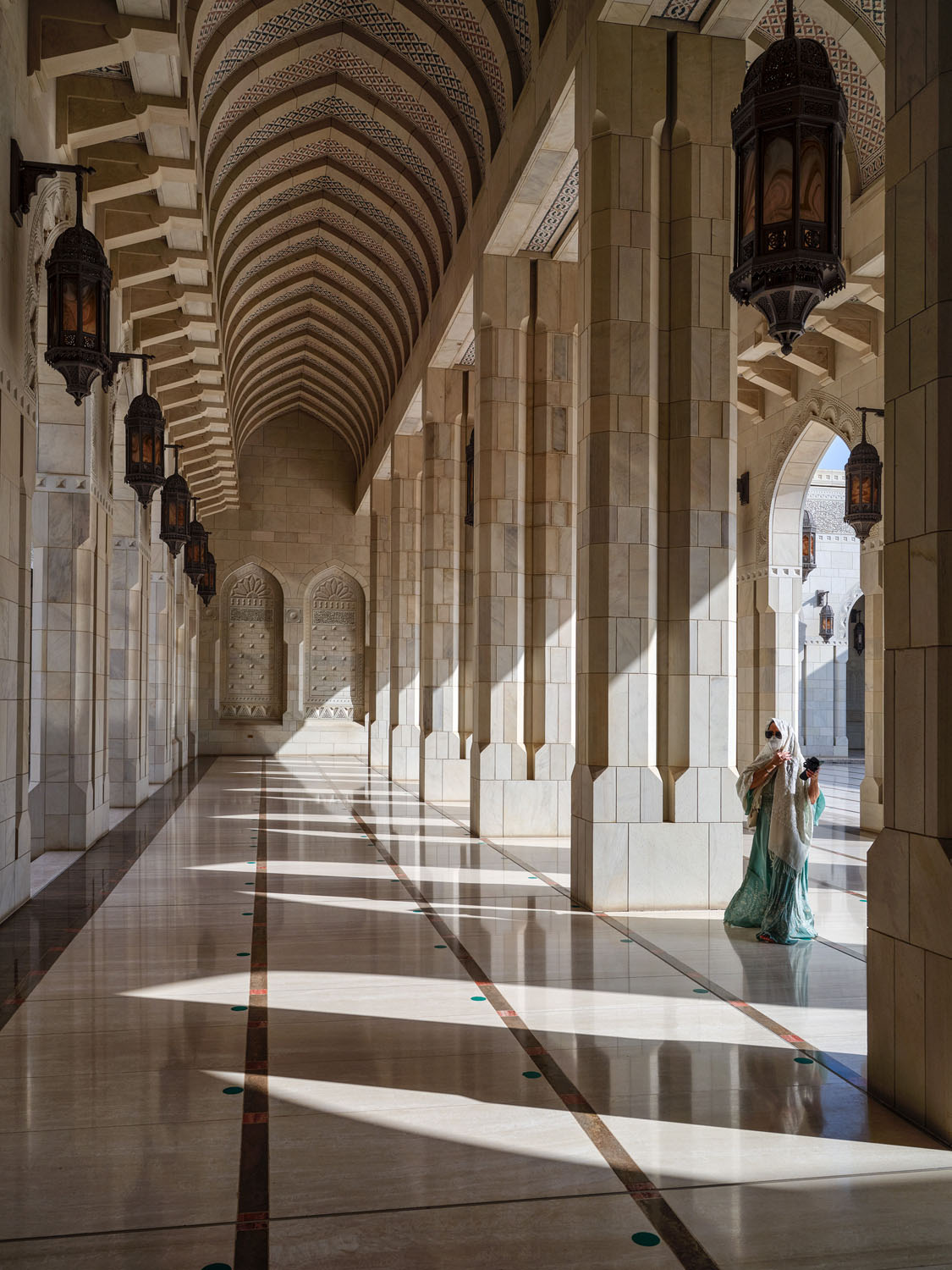
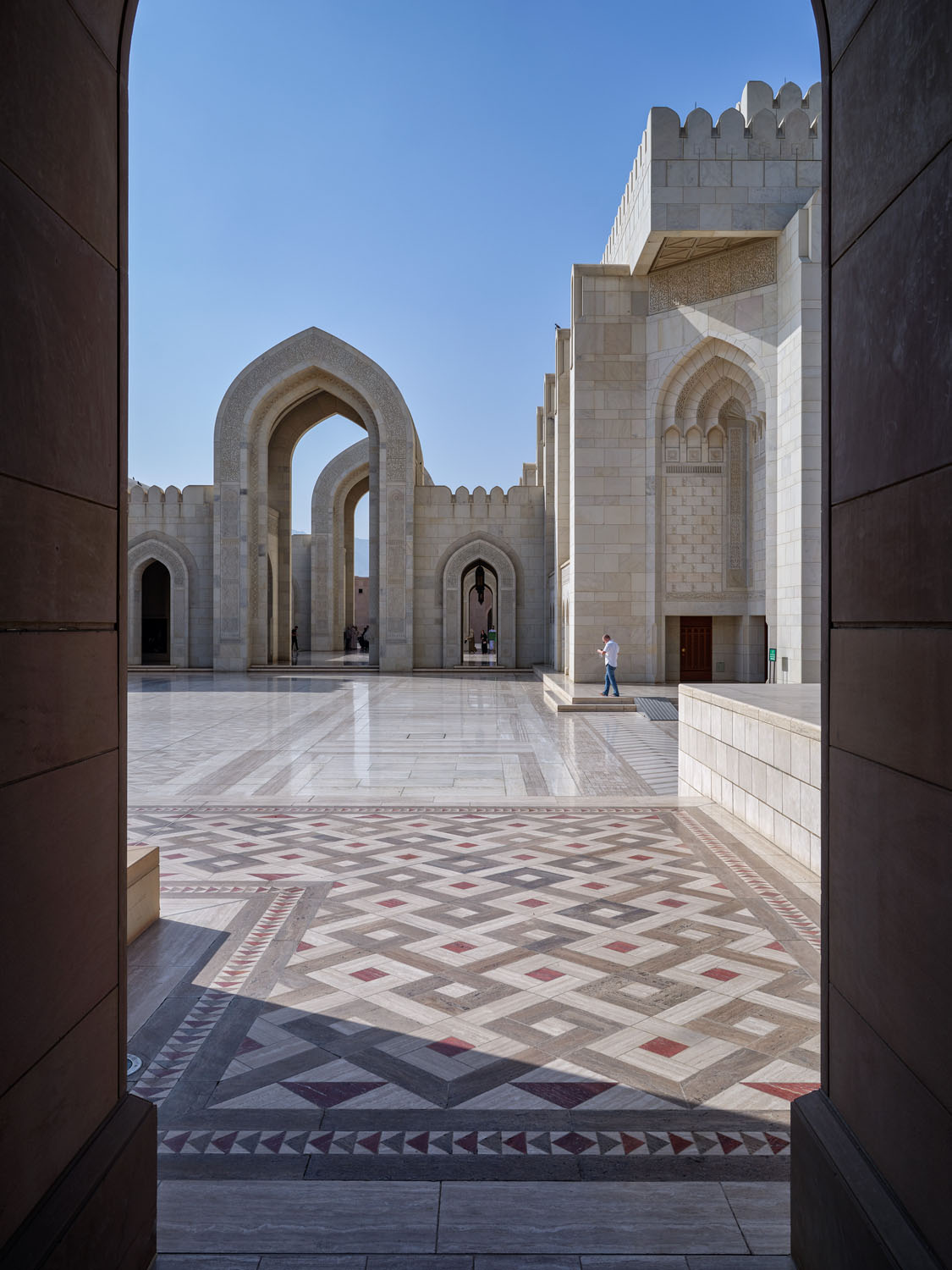
The riwaq (archways) provide pleasant shade under the Gulf of Oman sun
RIGHT: Fuji GFX 100 . Fuji GF32-64mmF4 @33mm . f/13 . 1/200″ . ISO 125 . WB 4.250 K . hand-held
A spacious landscaped park leads to the mosque and its white marble decorated forecourt
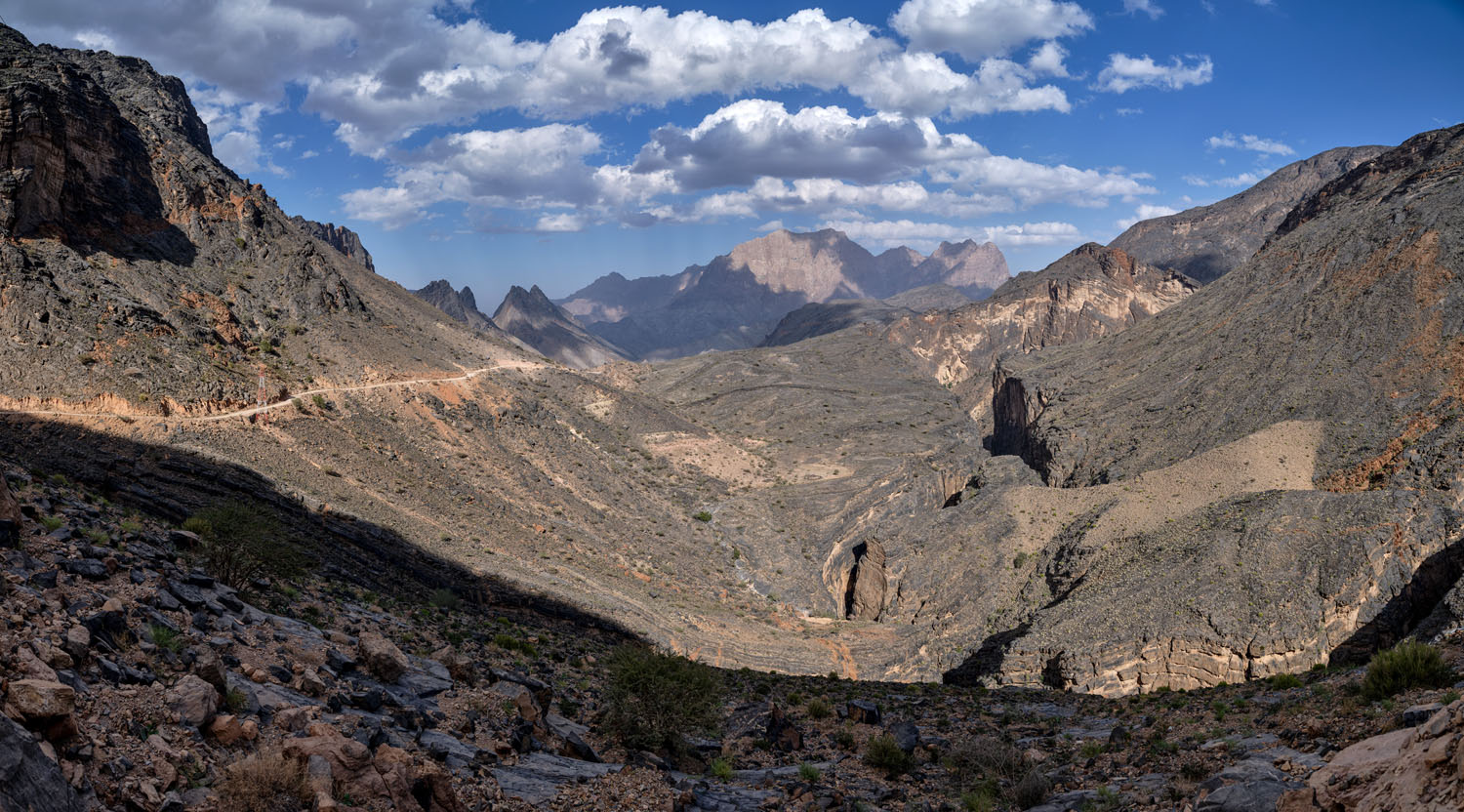
On the way inland we cross the Hajar Mountains through the Wadi Bani Awf
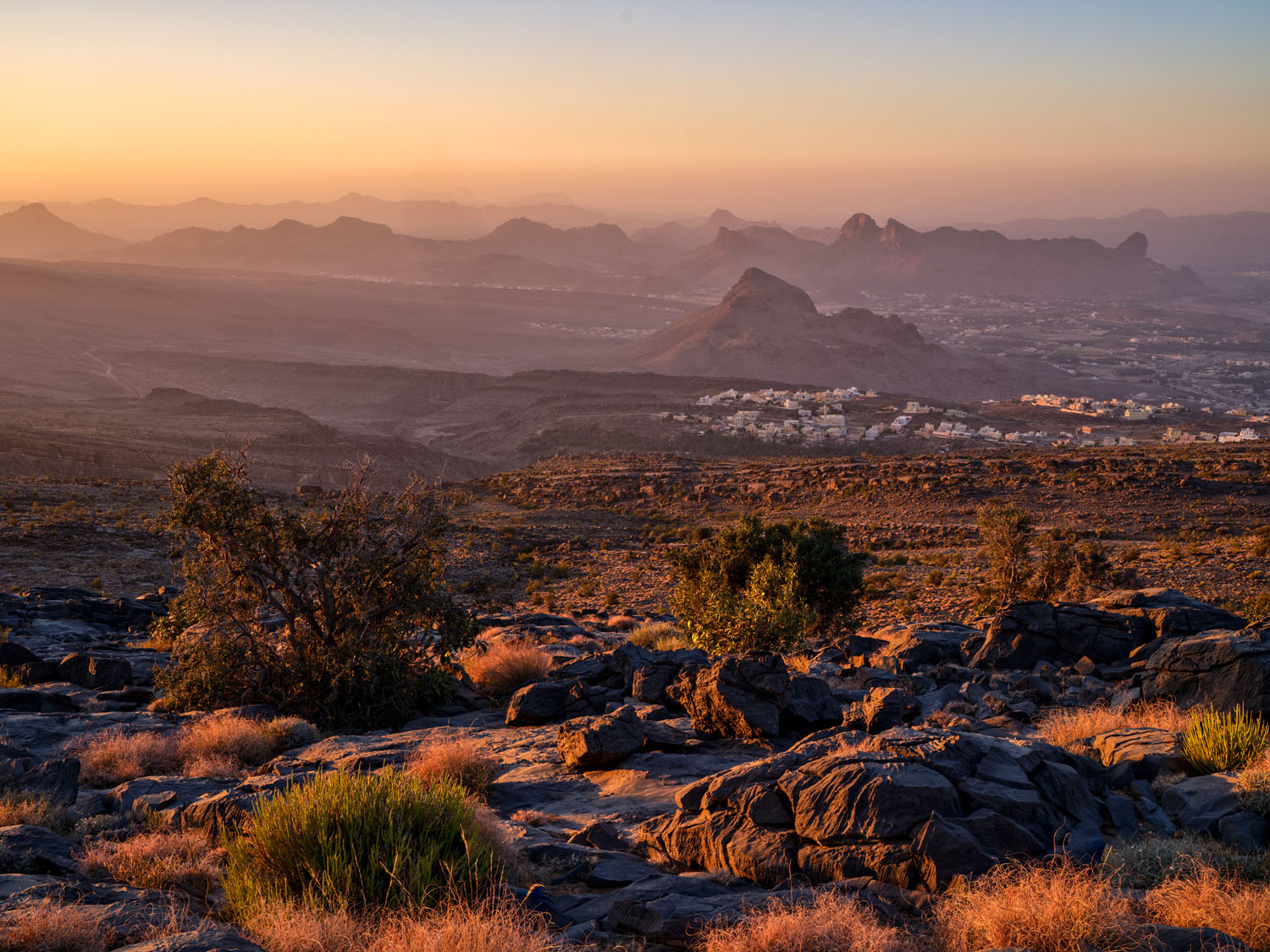
Dawn over the oasis al-Hamra, which means ‘the beautiful one’
Once inland, we explore the oases of Bahla and Nizwa with their impressive clay fortresses. Also worth seeing is Jibreen Castle, a palace-fortress from the 17th century. Our cultural tour ends at the market in the oasis of Sinaw. It is famous for its camel and fish market. Unfortunately, this has lost its charm with the COVID events as it has been distributed to different areas of the city. Our attention is, therefore, on the historical, partly multi-story adobe buildings of Sinaw.
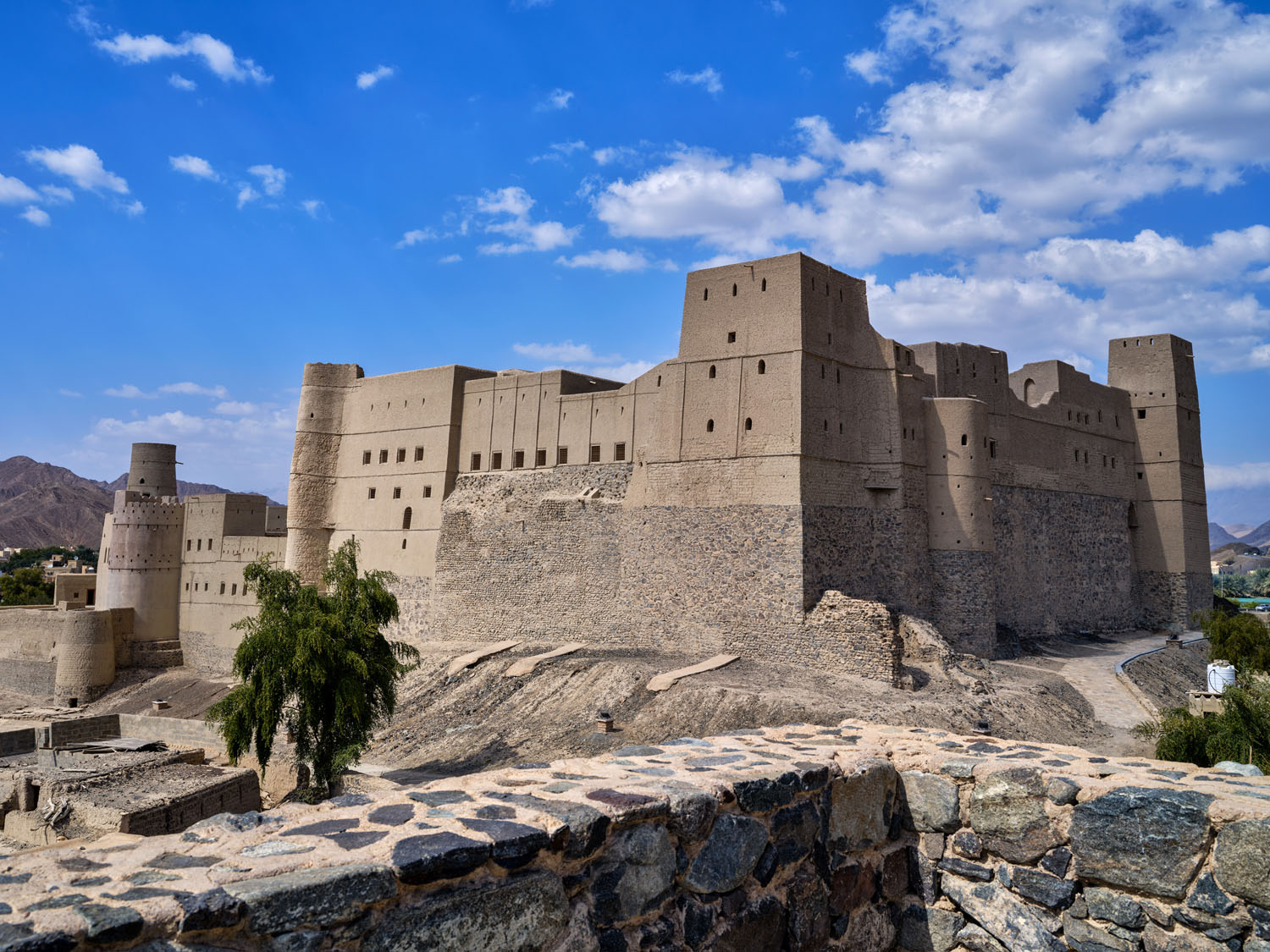
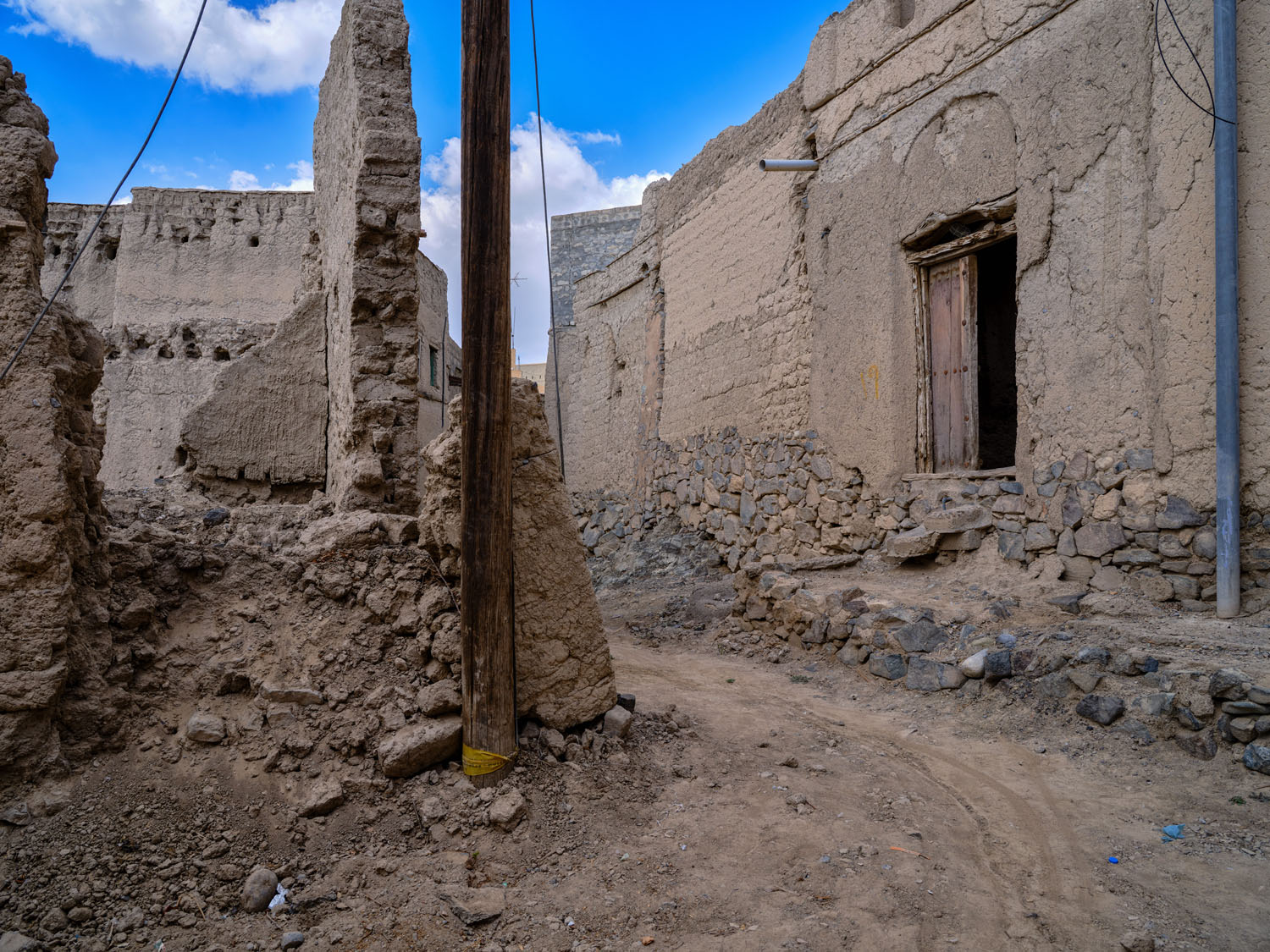
View of the UNESCO World Heritage Site Bahla Fort. It is the largest mud/clay fortress in Oman
RIGHT: Fuji GFX 100 . Fuji GF32-64mmF4 @32mm . f/11 . 1/160″ . ISO 125 . WB 4.550 K . hand-held
Below the Fort of Bahla lies the historic mud/clay city with its ruins
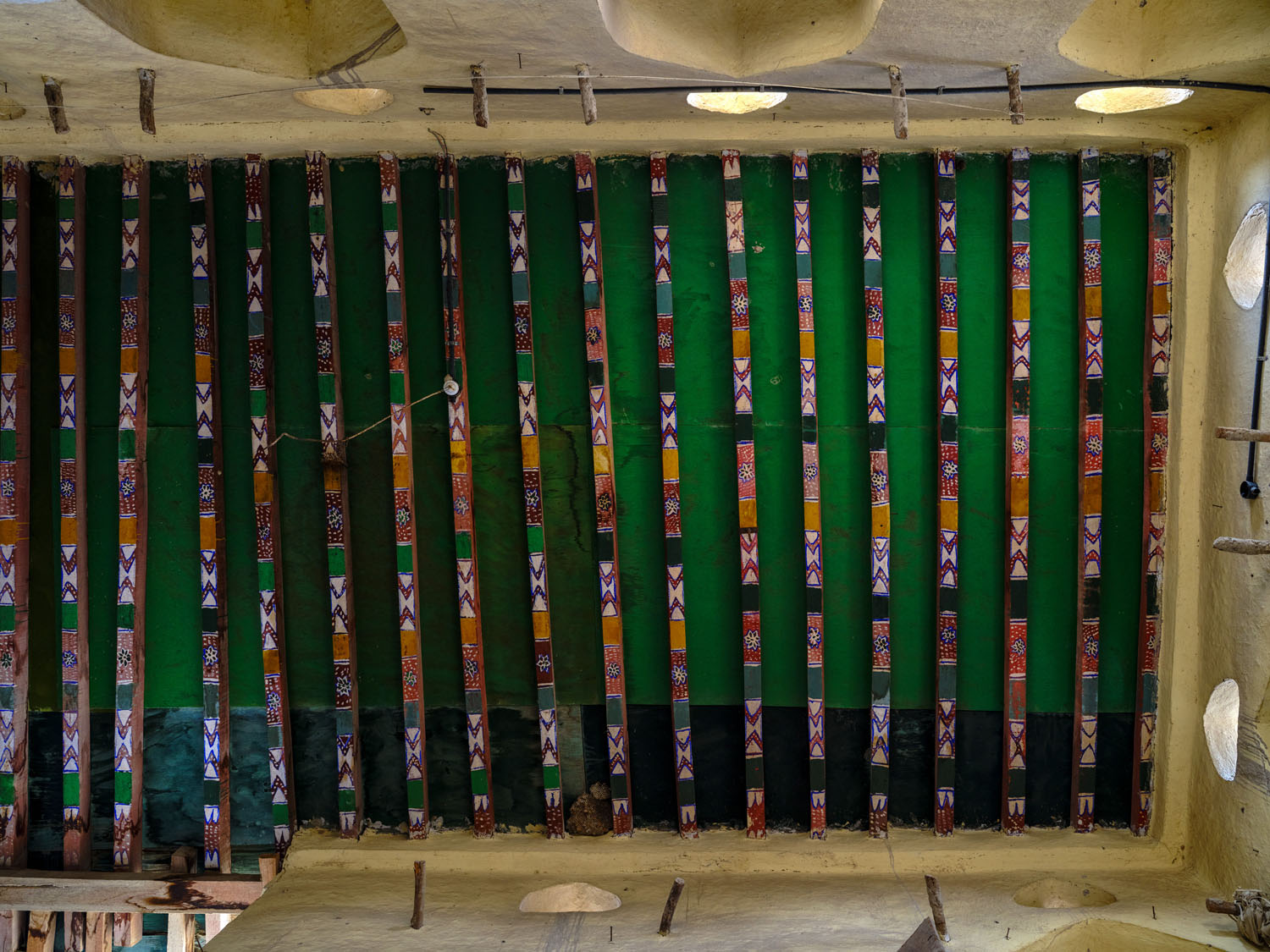
In one of the houses left open in the historic mud/clay city, we come across a richly decorated wooden ceiling above our heads
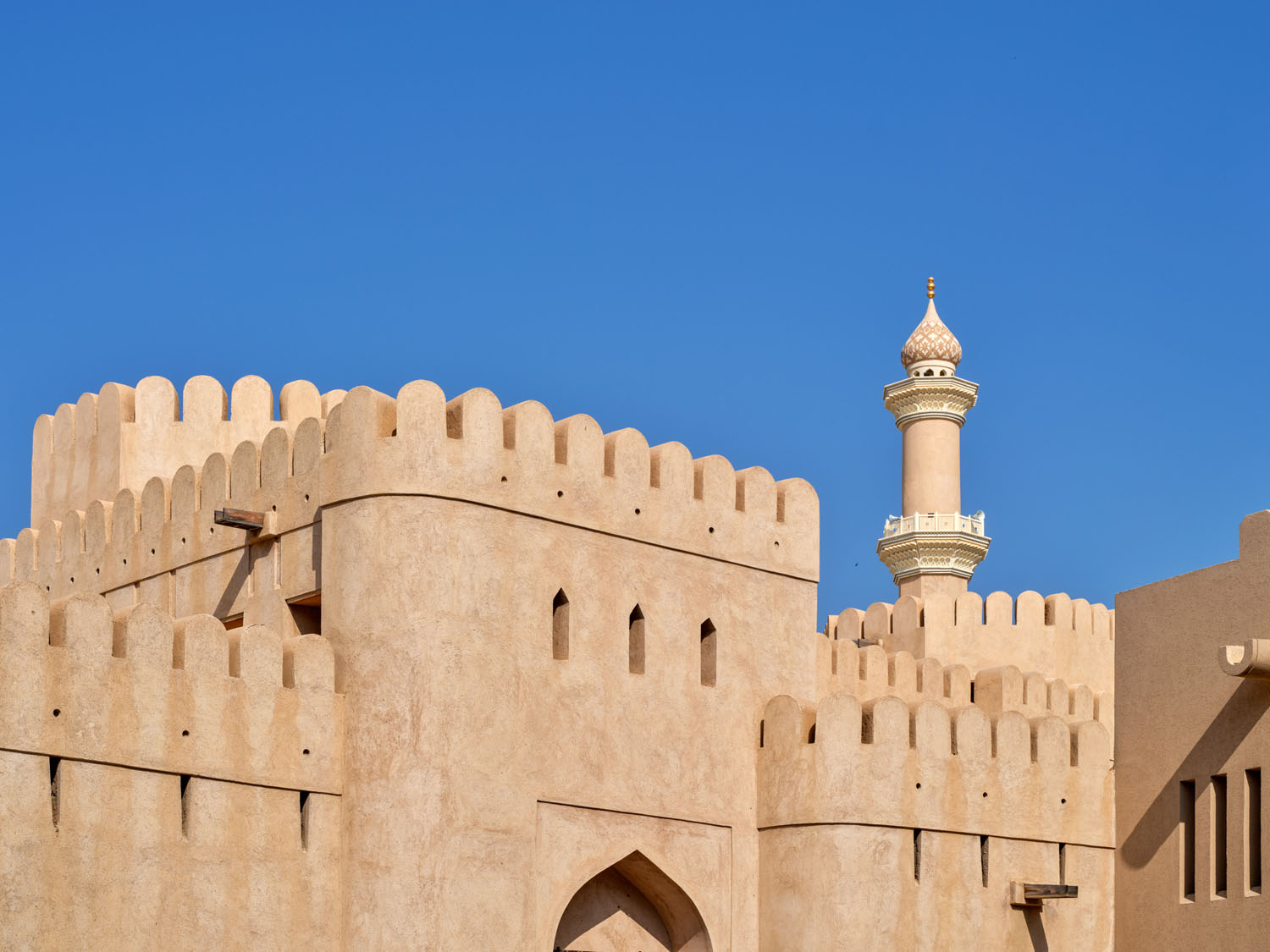
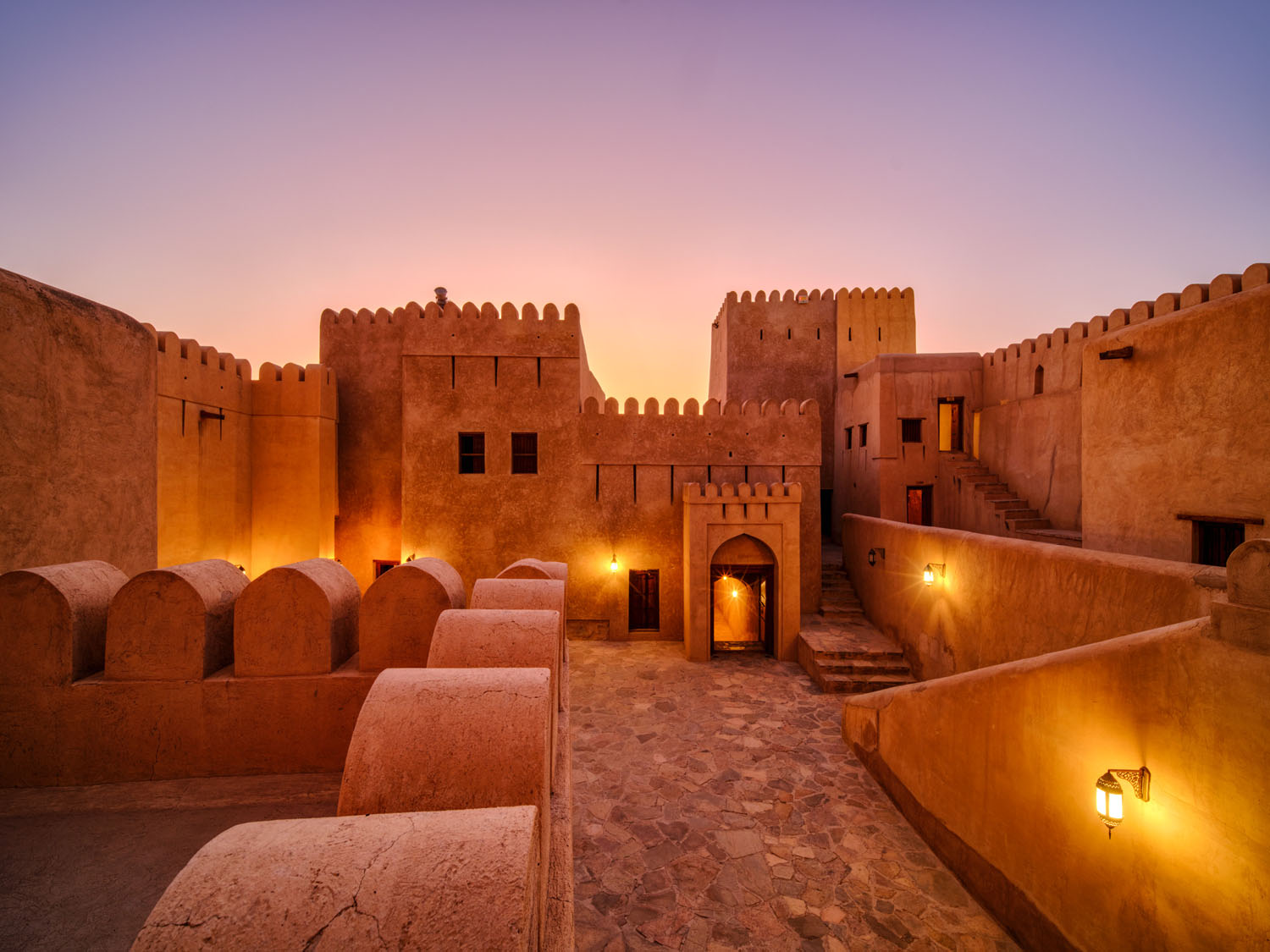
The walls and battlements of Nizwa Fort rise protectively under the bright blue sky above the oasis
RIGHT: Fuji GFX 100 . Laowa 17mmF1.8 . f/22 . 4″ . ISO 200 . WB 5.575 K . Tripod
That evening, I was hoping for a sky pierced by clouds and flooded with rays of sunlight.
Instead, a light-filled cloudless evening sky over the battlements awaits me at the fort.
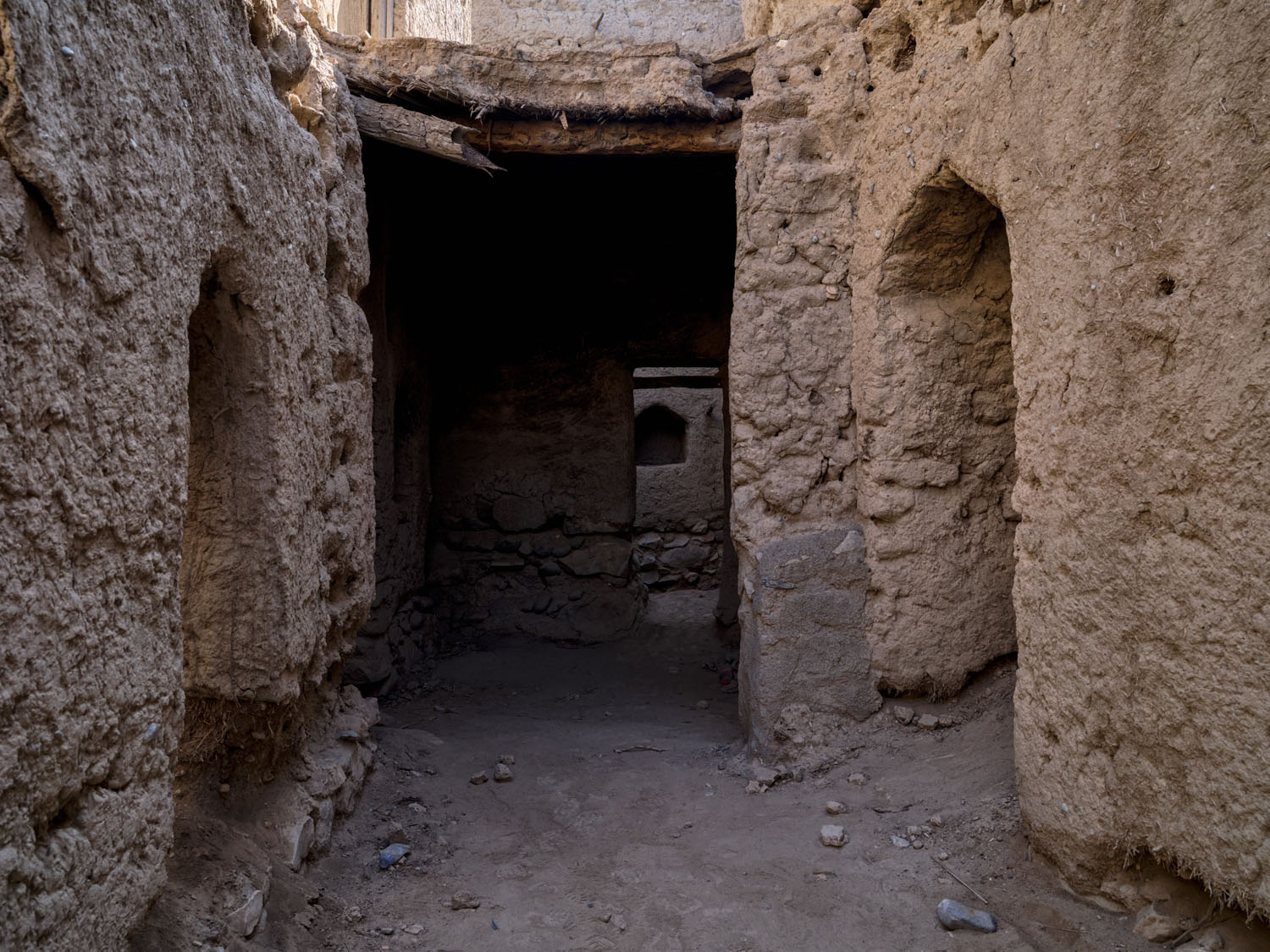
As in Bahla, an open old town slumbers in the immediate vicinity of the Nizwa Fort.
This is being restored in parts and will be reopened as a hostel.
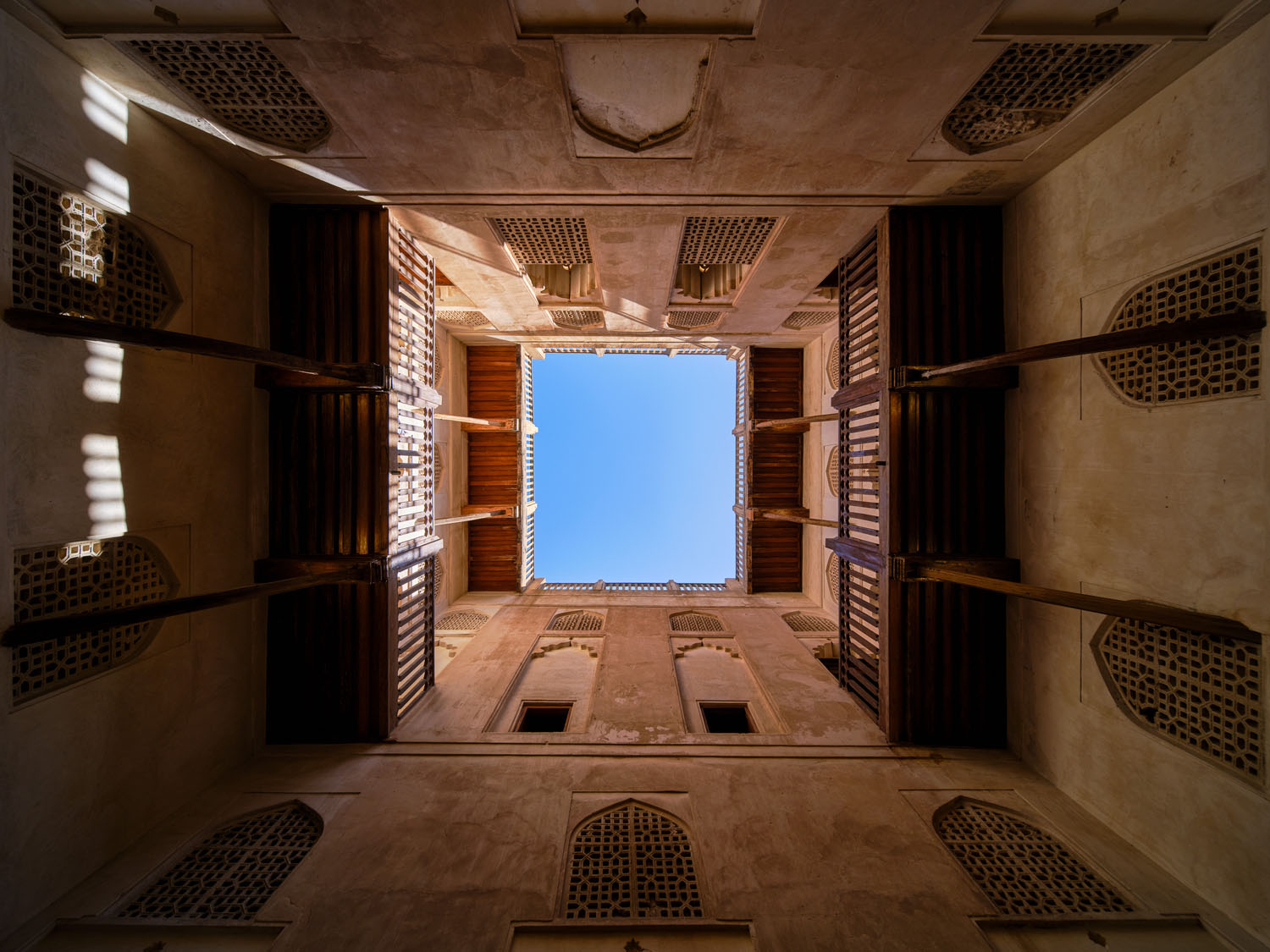

Lying with your back on the ground, an unusual perspective opens up in the courtyard of the former palace fortress ‘Jibreen Castle’
RIGHT: Fuji GFX 100 . Fuji GF32-64mmF4 @38mm . f/14 . 1/320″ . ISO 100 . WB 4.450 K . hand-held
In the courtyard of Jibreen Castle. This is the place to celebrate minimalism
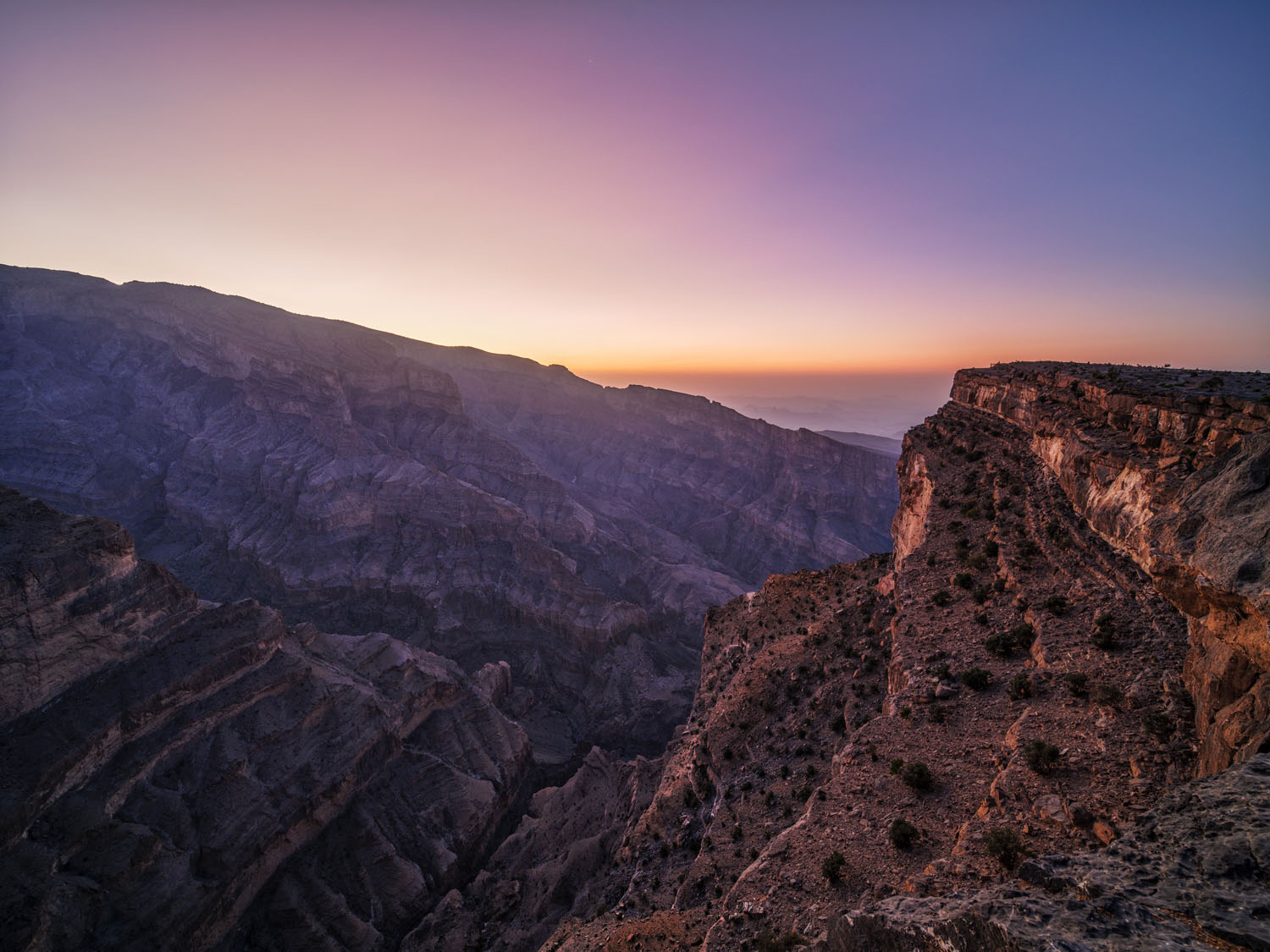
Around four o’clock in the morning, we set off from Nizwa to reach the viewpoint opposite Jebel Sahm in time for dawn.
Here our view falls deep down into the wild, rugged Wadi Nakhr.

The view from the dirt road in Wadi Nakhr reaches almost 2,000 meters up to the summit of Jebel Shams, at just over 3,000 meters, the highest peak in Oman. Panorama from XX portrait shots (stitched together in Photoshop).
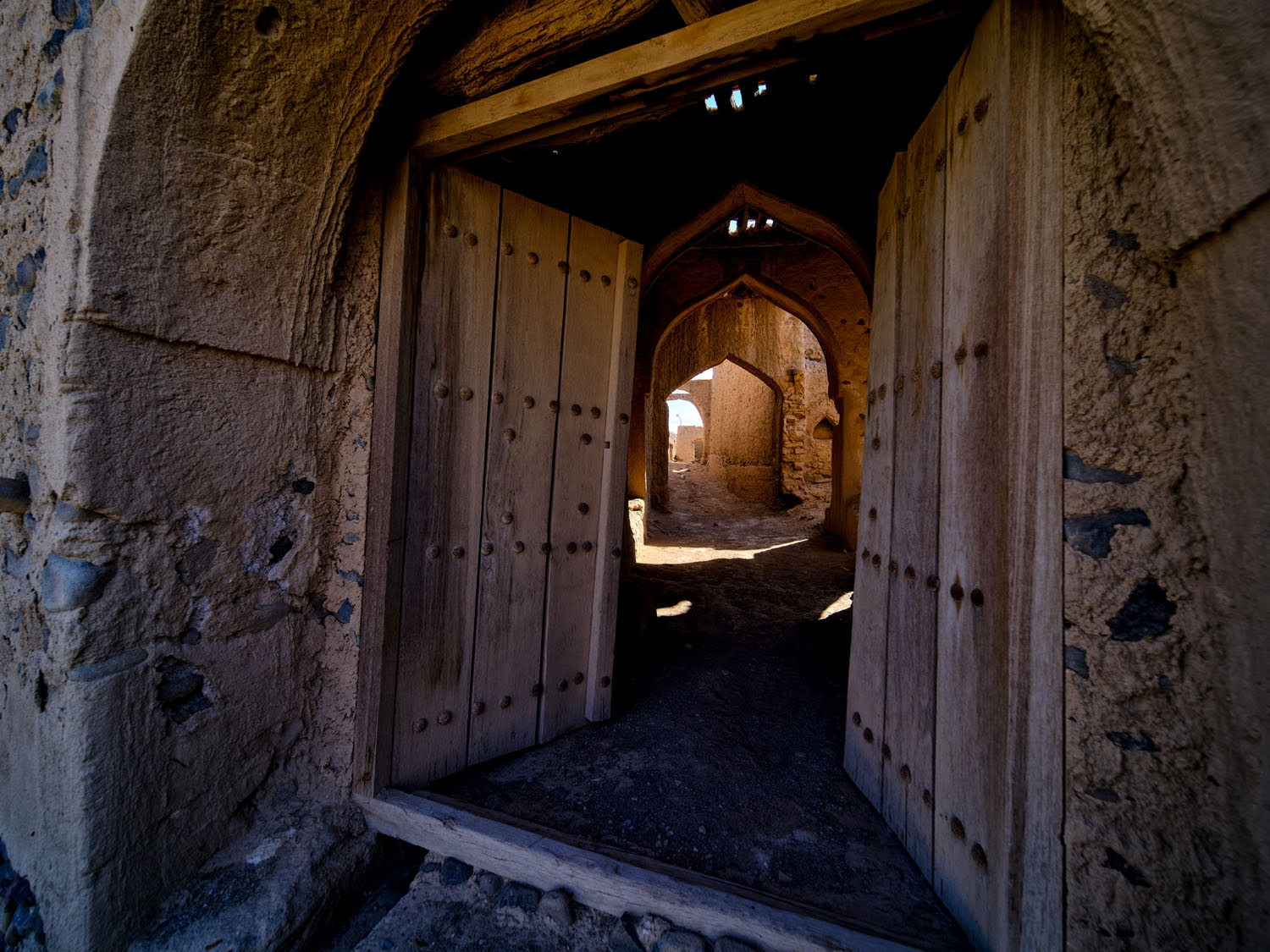
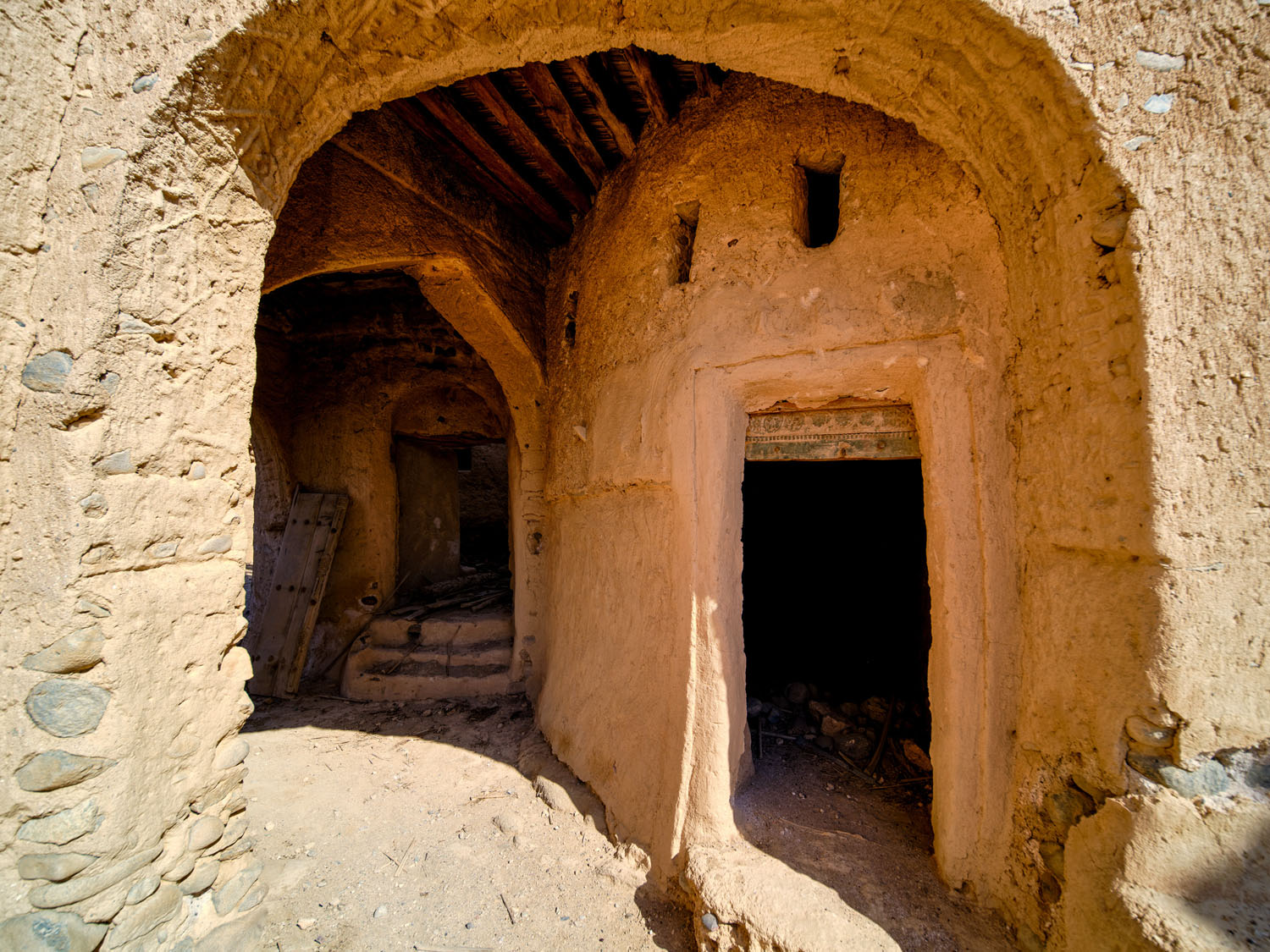
In the Sinaw oasis, the traditional camel and fish market is considered the highlight. But Corona and its effects have torn the market apart.
Thus, our photographic gaze falls on the open mud/clay city, which sometimes has multi-story buildings.
RIGHT: Fuji GFX 100 . Laowa 17mmF1.8 . f/16 . 1/200″ . ISO 100 . WB 4.350 K . hand-held
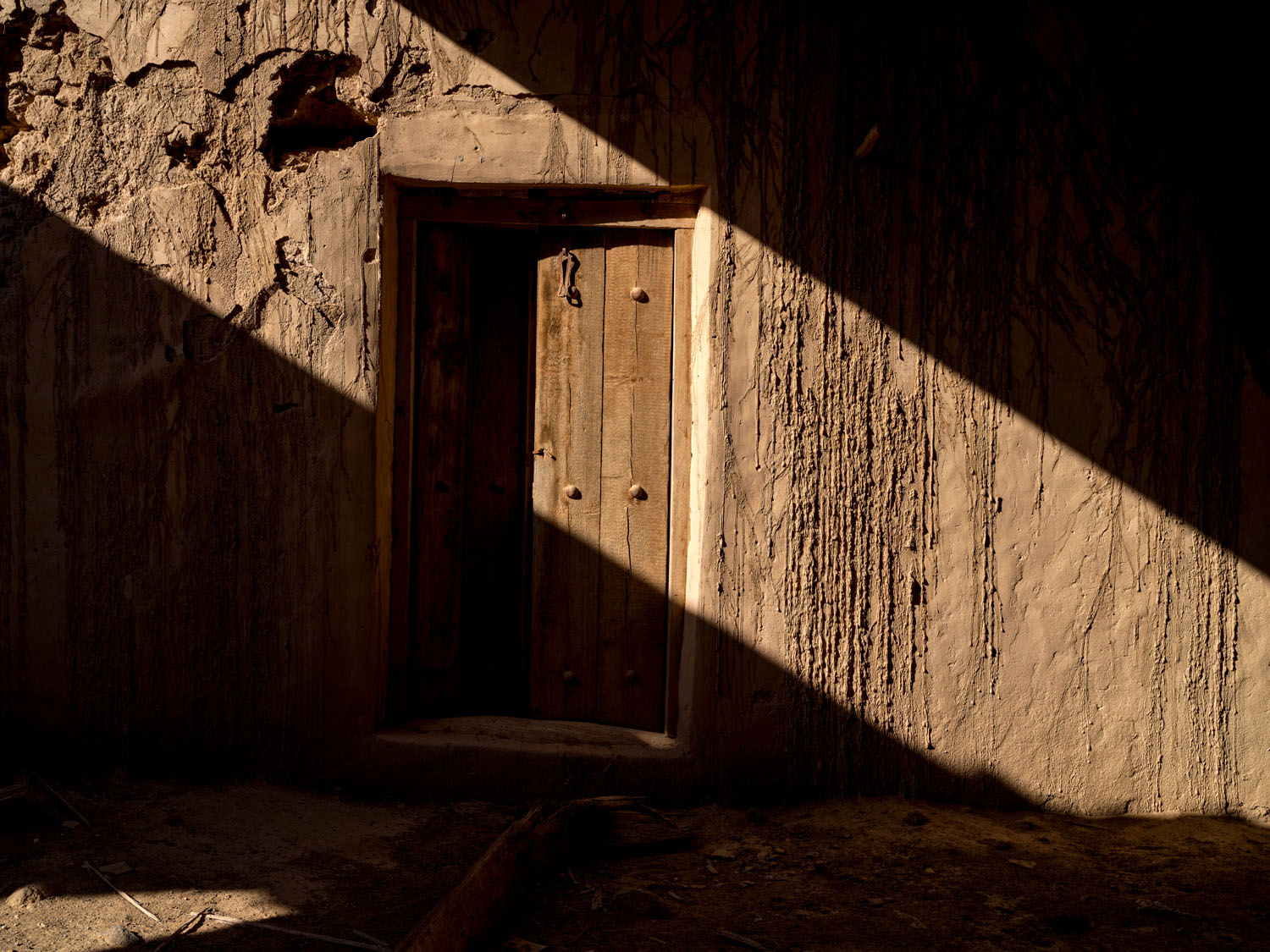
After a few kilometers, we leave civilization and the asphalt road. In the beginning, we follow the track through the gravel plain, before we continue following a cliff edge in the al-Huqf without a path. The al-Huqf is a small stone desert, completely devoid of vegetation except for some low bushes. It stretches roughly between the Arabian Sea and the Rub al-Khali inland. Here we encounter wild rock formations, shaped day in and day out by wind and weather. Usually, we set up our camps in the immediate vicinity of rock formations, depending on the fascination of the motif. This shortens our distances to the actual location in the twilight phases.
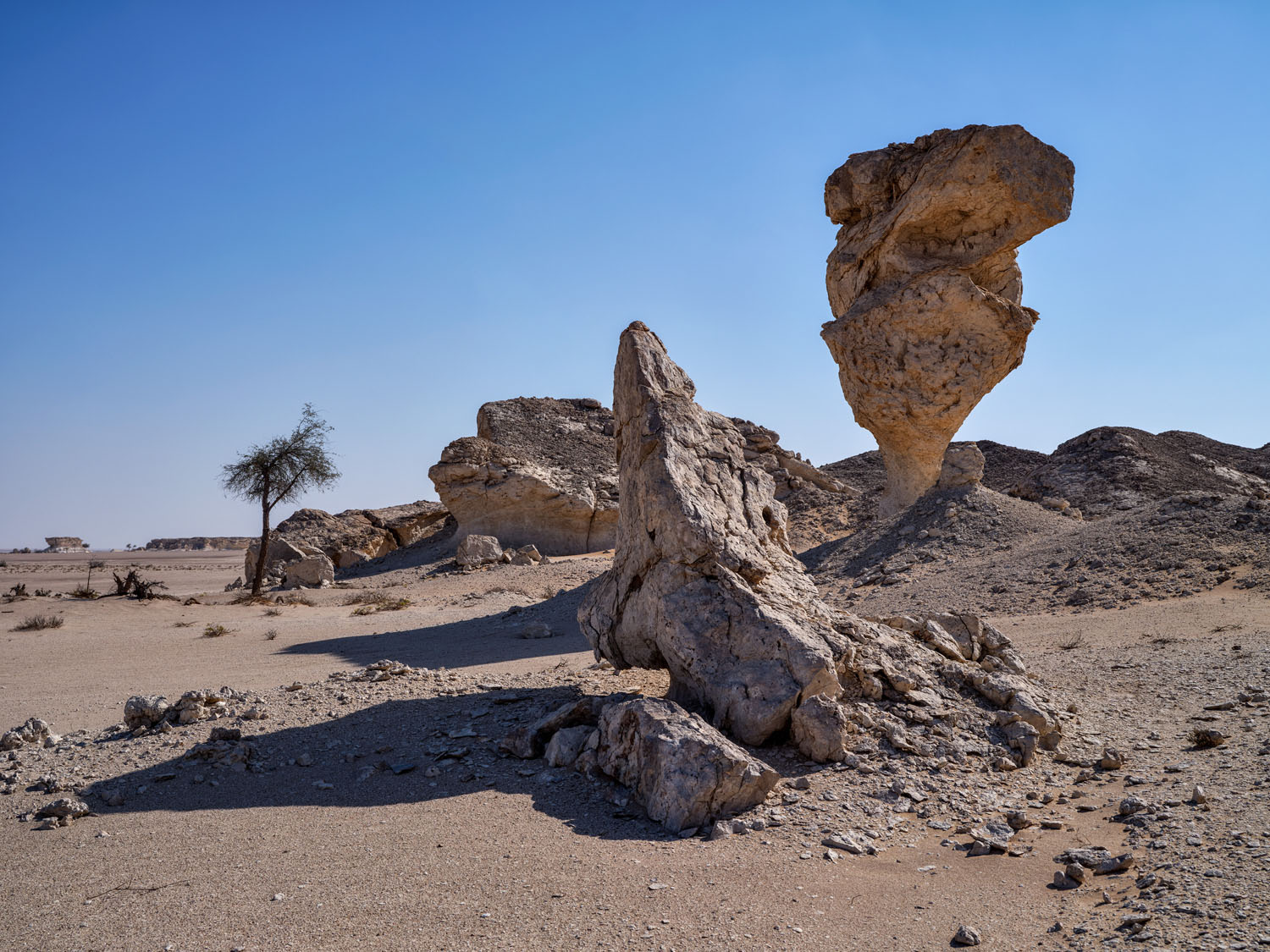
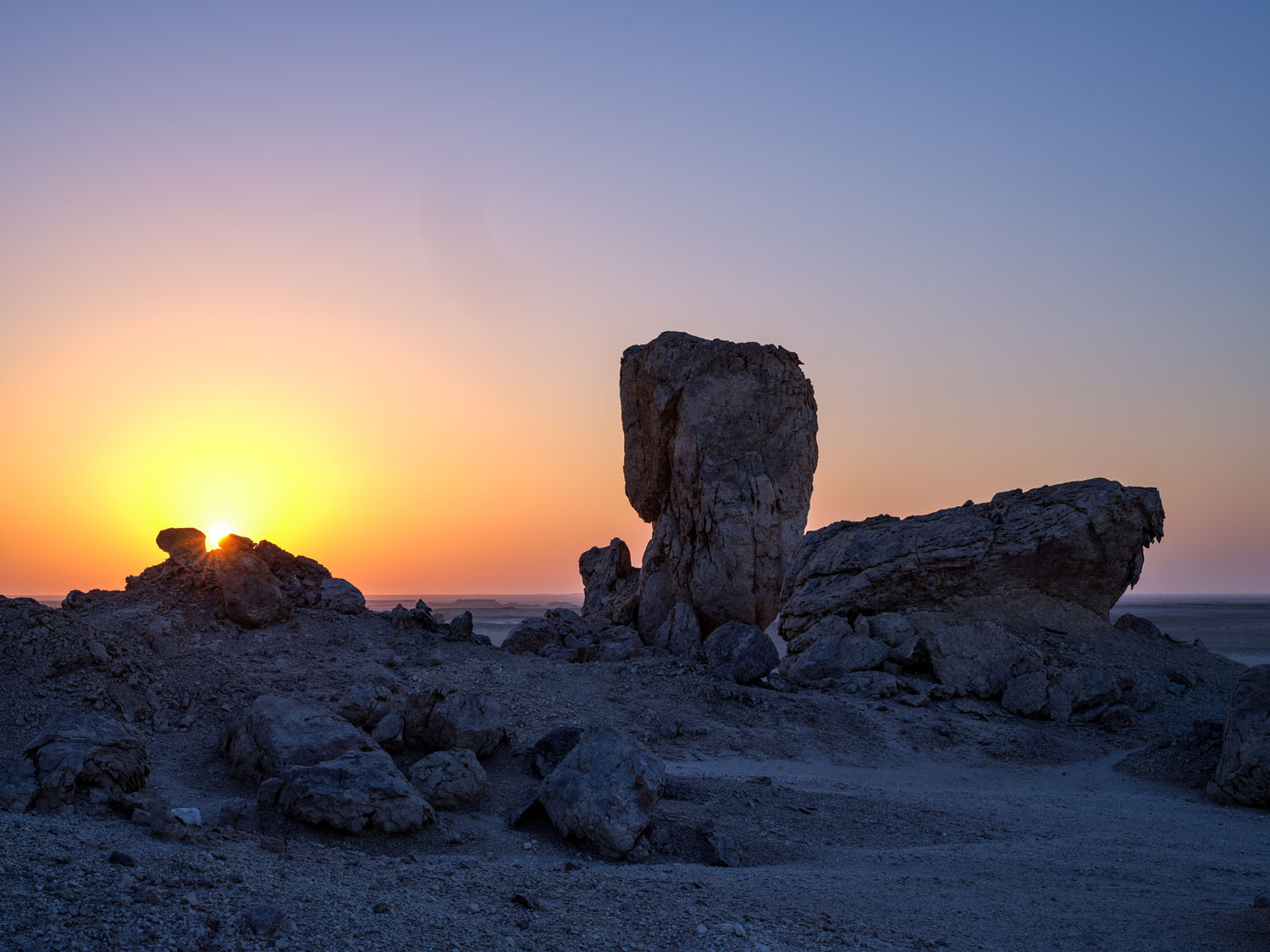
Desert part 1 – we have reached the rock formations shaped by wind and weather in the al Huqf…
RIGHT: Fuji GFX 100 . Fuji GF32-64mmF4 @53mm . f/16 . 1/30″ . ISO 100 . WB 4.350 K . Tripod
Sunrise at the whimsical rock formations of the al Hupf.
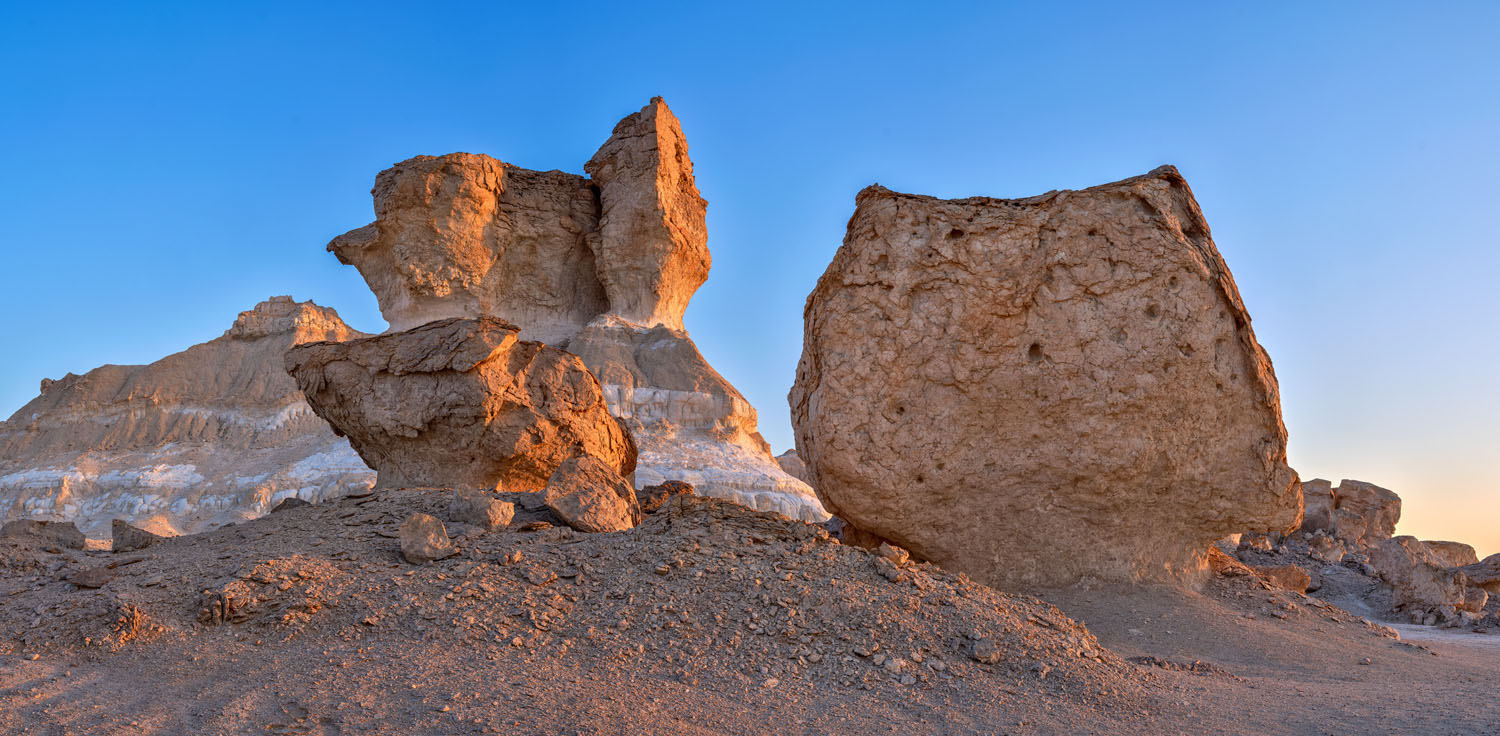
A five-frame vertical panorama of the steeply towering rock formation near our overnight campsite in the al Huqf.
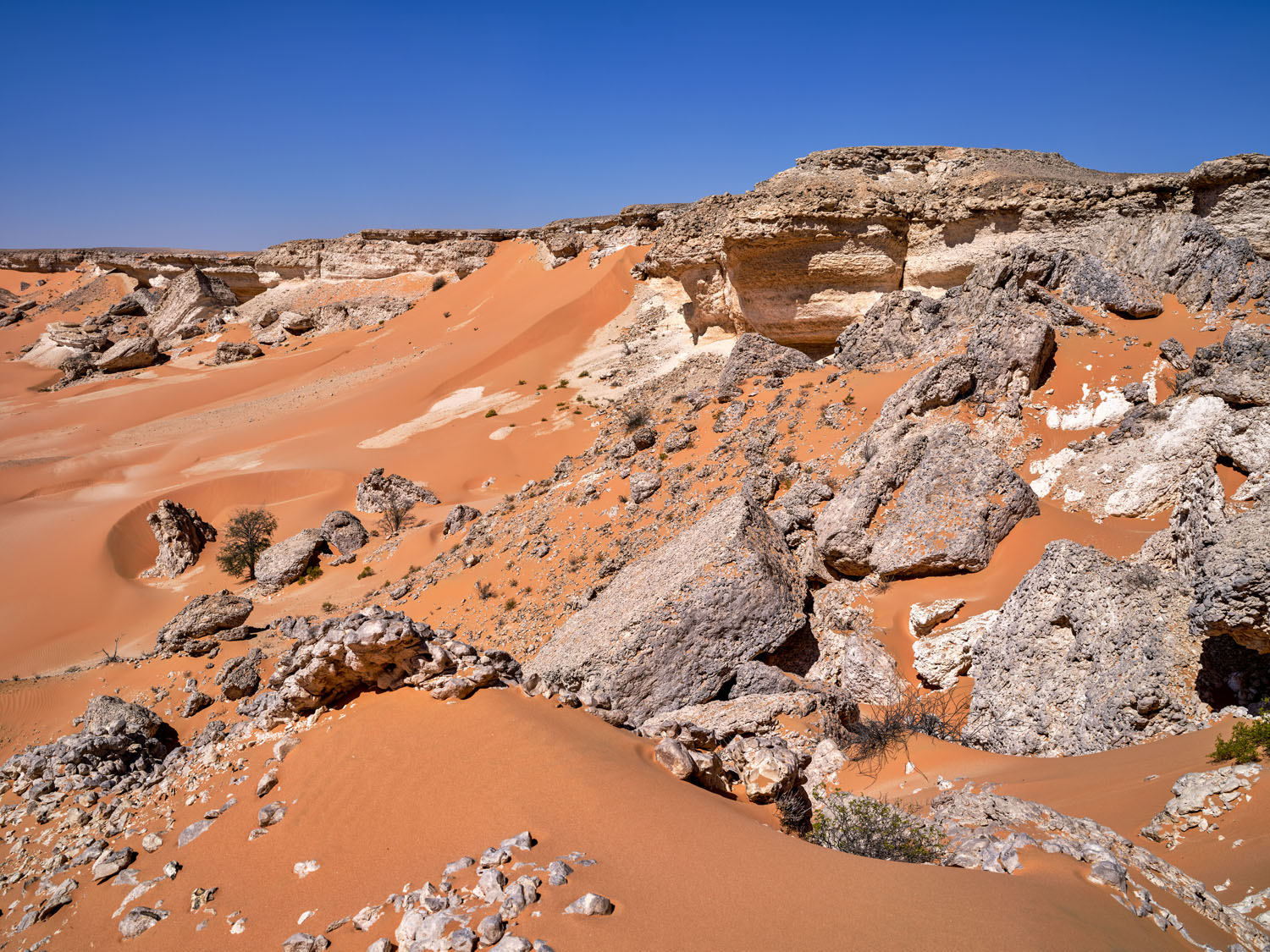
The approx. 60 m high cliff edge stretches for kilometers through the stony desert.
Occasionally we come across fossils from the Cretaceous period (about 66 million years old).
After three days we reach Haima, the capital of al-Wusta governorate. Here we charge all available batteries, back up the previous pictures from the memory cards to the laptops, and create data backups. We also replenish our food supplies and buy 240 liters of drinking water in six liter canisters. Likewise, we bunker 120 liters of service water in 20 liter canisters on the roof. Shortly before we leave the black road again, we refuel and bunker another 100 liters of fuel, also in the canisters carried for it on the roof. A few kilometers southeast of Haima, we leave the paved road again and dive into our Rub al-Khali adventure.
The Rub al-Khali – also known as the “Empty Quarter”. It is the biggest pure sand desert on earth, covering an area of about 680,000 km². As Europeans, we often have the idea that the desert is a vegetationless expanse of sand. This is not necessarily so: here and there, small bushes and shrubs climb up the steep sandy slopes, but in the mass they are hardly more than waist high. Occasionally we come across small clusters of trees in the plain, indicating an underground water vein, but this is a rare exception. A 360° panoramic view quickly reveals: there is nothing here that the urban eye can hold on to! Sand, dunes, dune valleys and more sand.
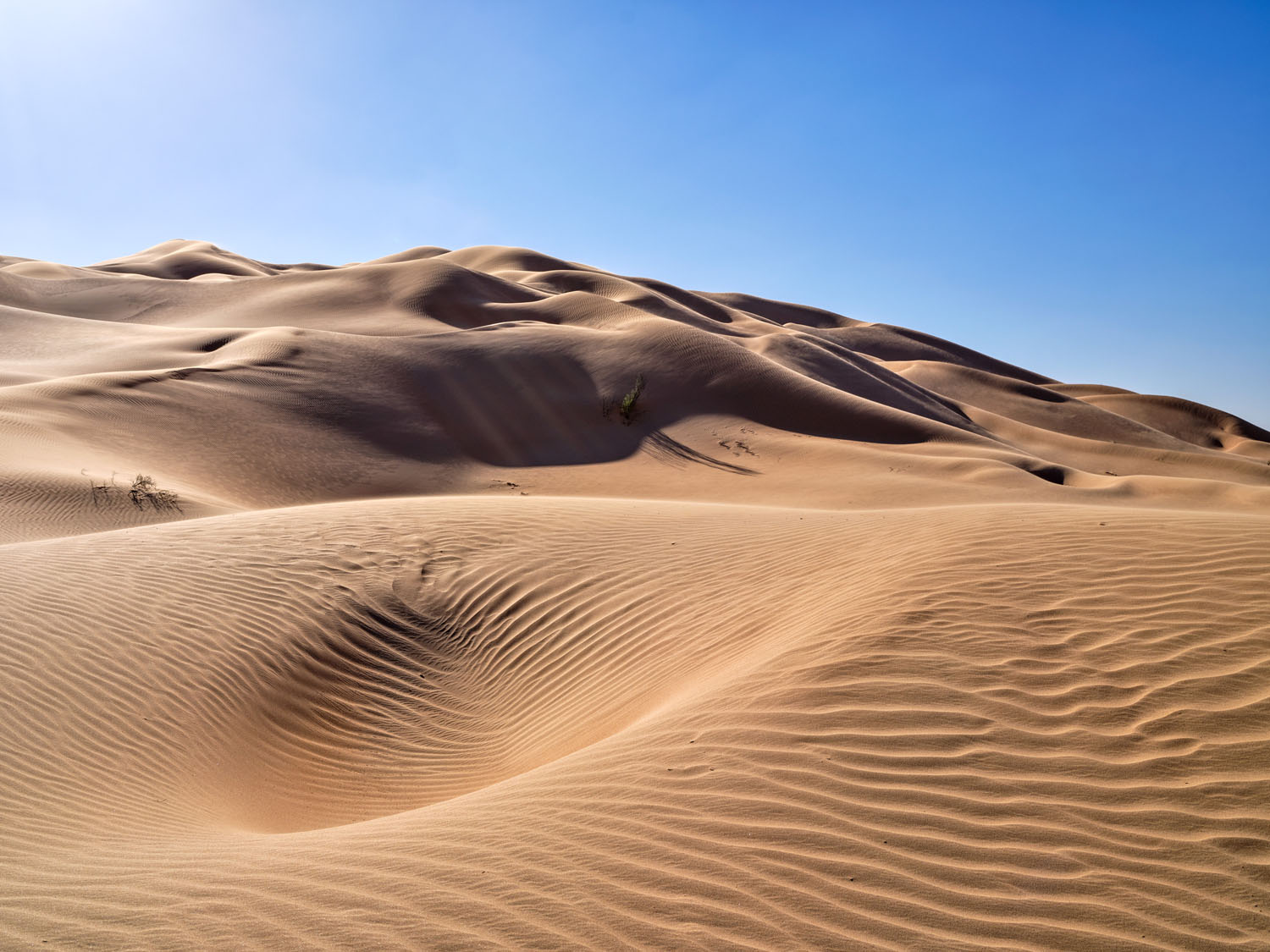
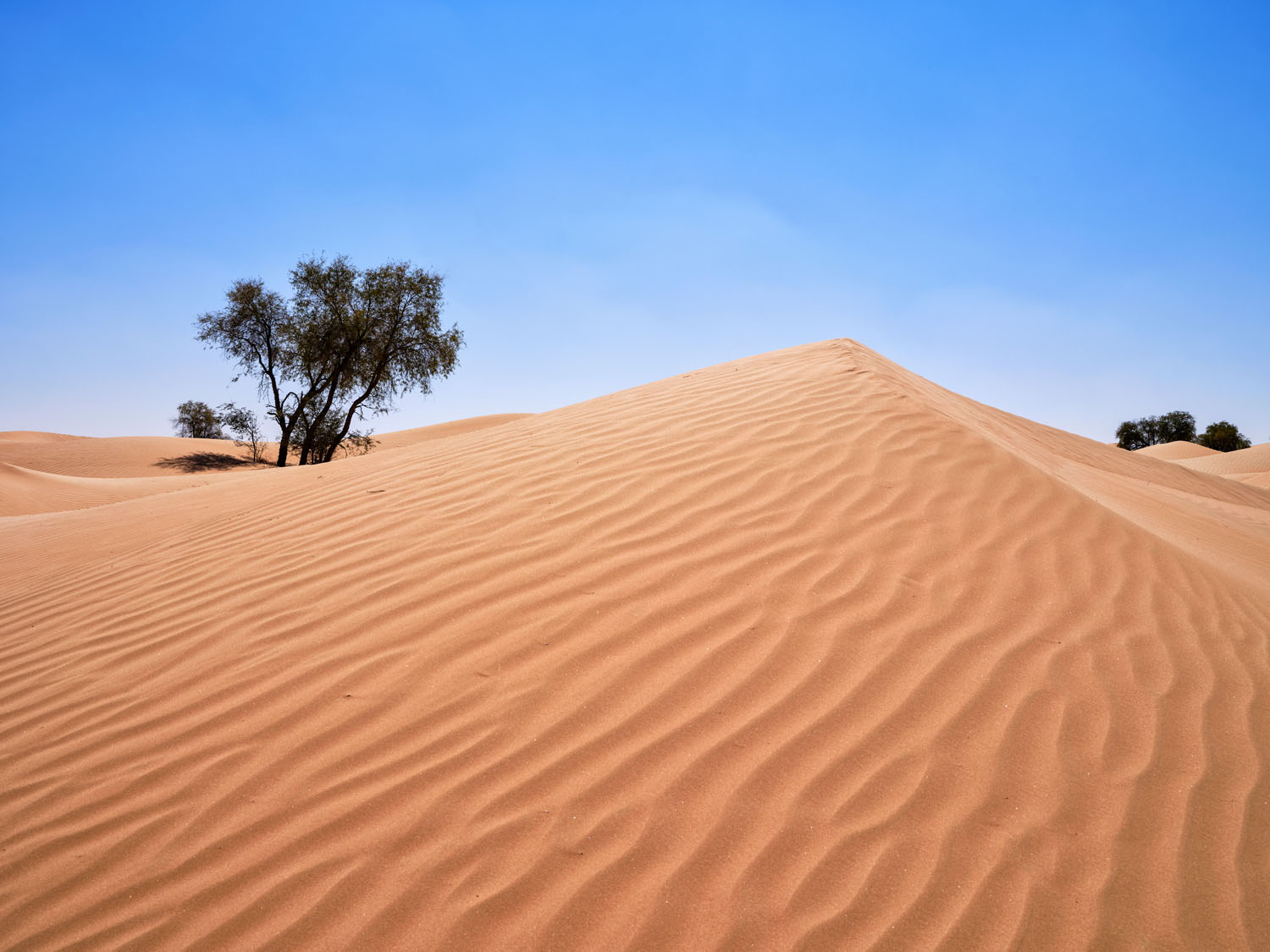
Desert part 2 – our Rub al-Khali adventure takes its course. We dive into the dunes of the largest sand desert on earth.
RIGHT: Fuji GFX 100 . Fuji GF32-64mmF4 @42mm . f/16 . 1/250″ . ISO 125 . WB 4.750 K . hand-held
A group of trees surrounded by smaller dunes. Seemingly there is an underground vein of water beneath the surface of the earth.
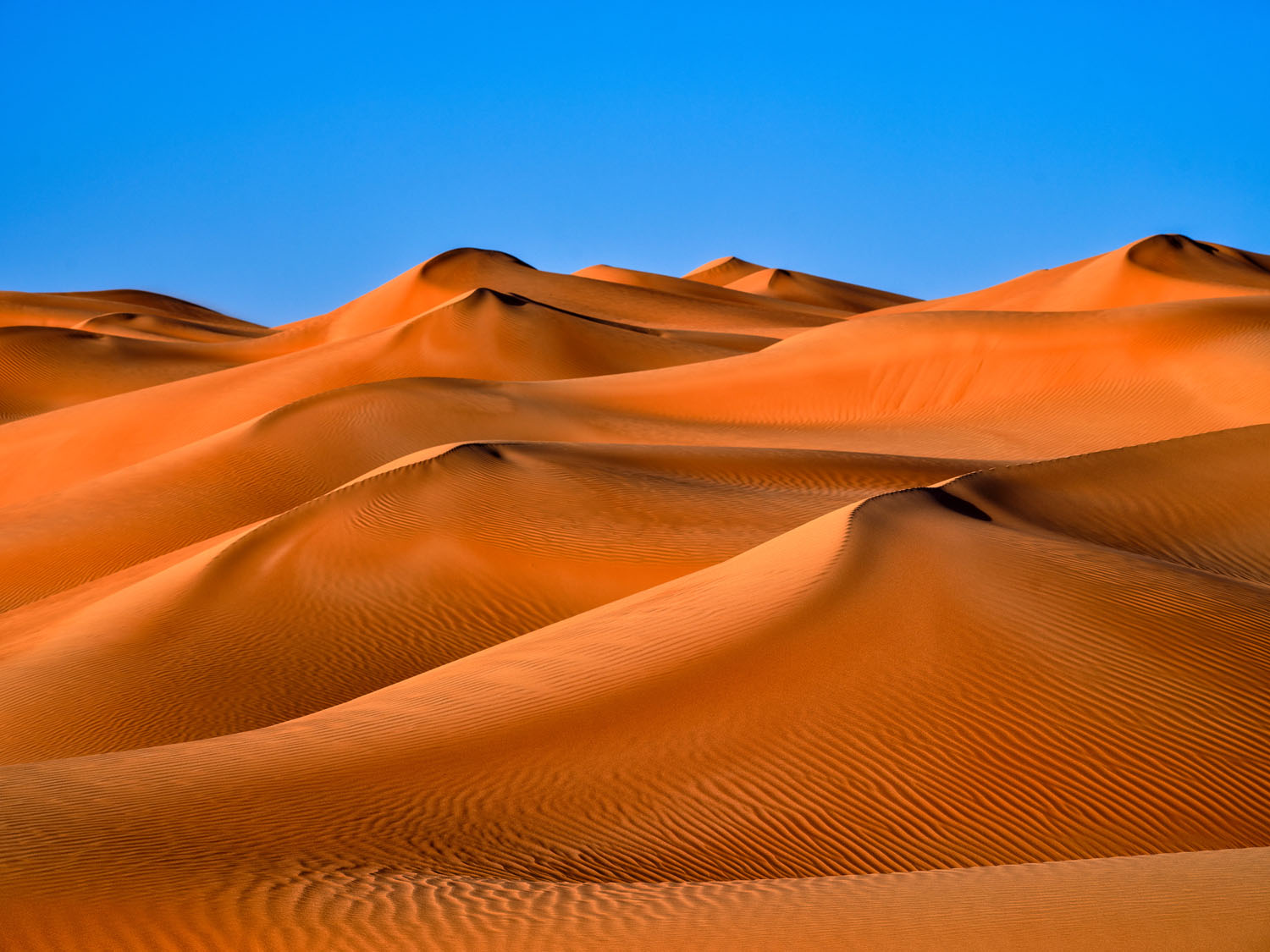
In the evening sun, a track of dune crest after dune crest with their fine structures in the desert sand.

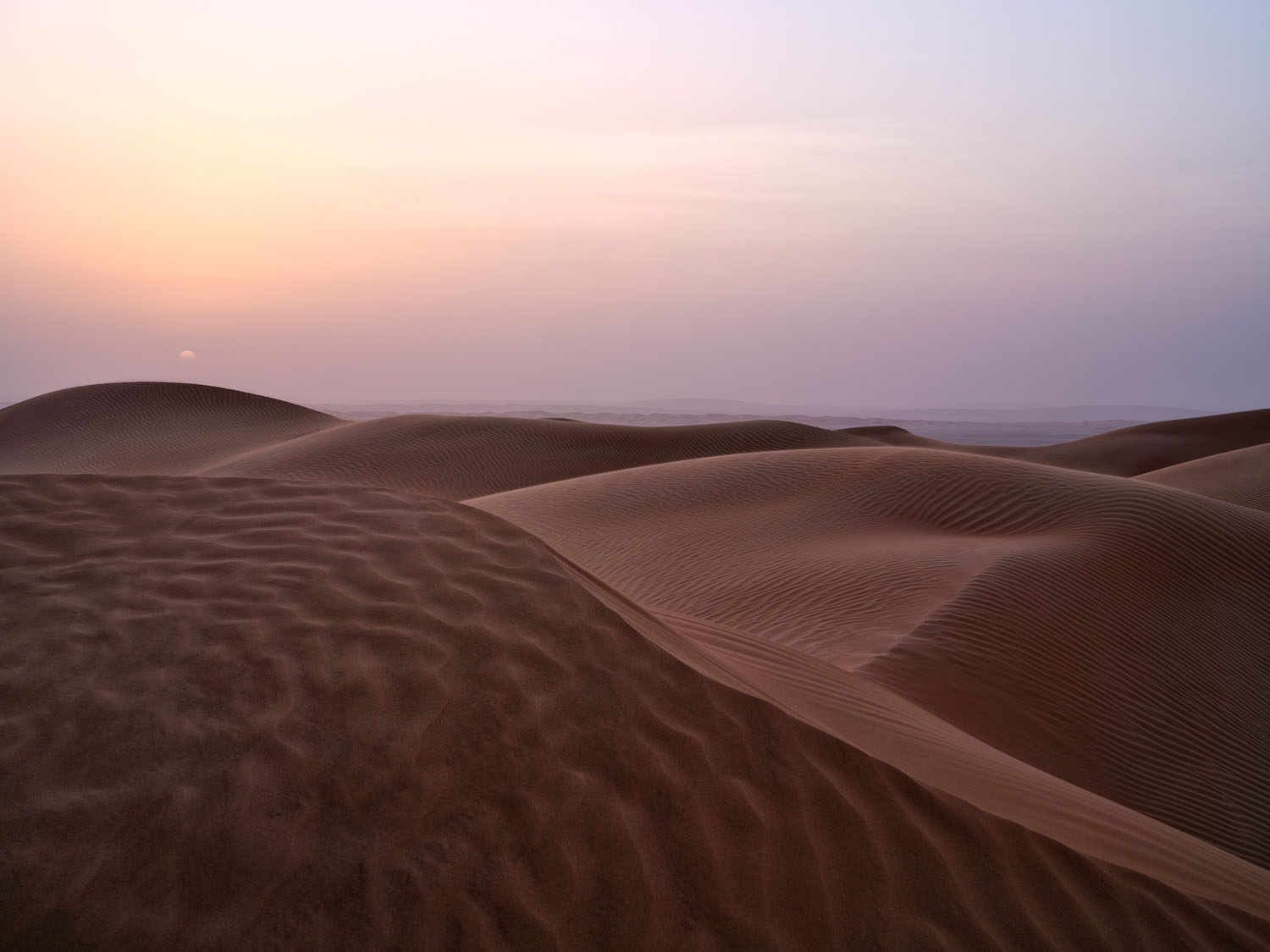
RIGHT: Fuji GFX 100 . Fuji GF45-100mmF4 @55mm . f/16 . 1/15″ . ISO 160 . WB 4.550 K . Tripod
Slowly and unexcitedly the sun appears shimmering through the morning haze.
Within minutes, it spreads its heated rays over the sandy sea of dunes.
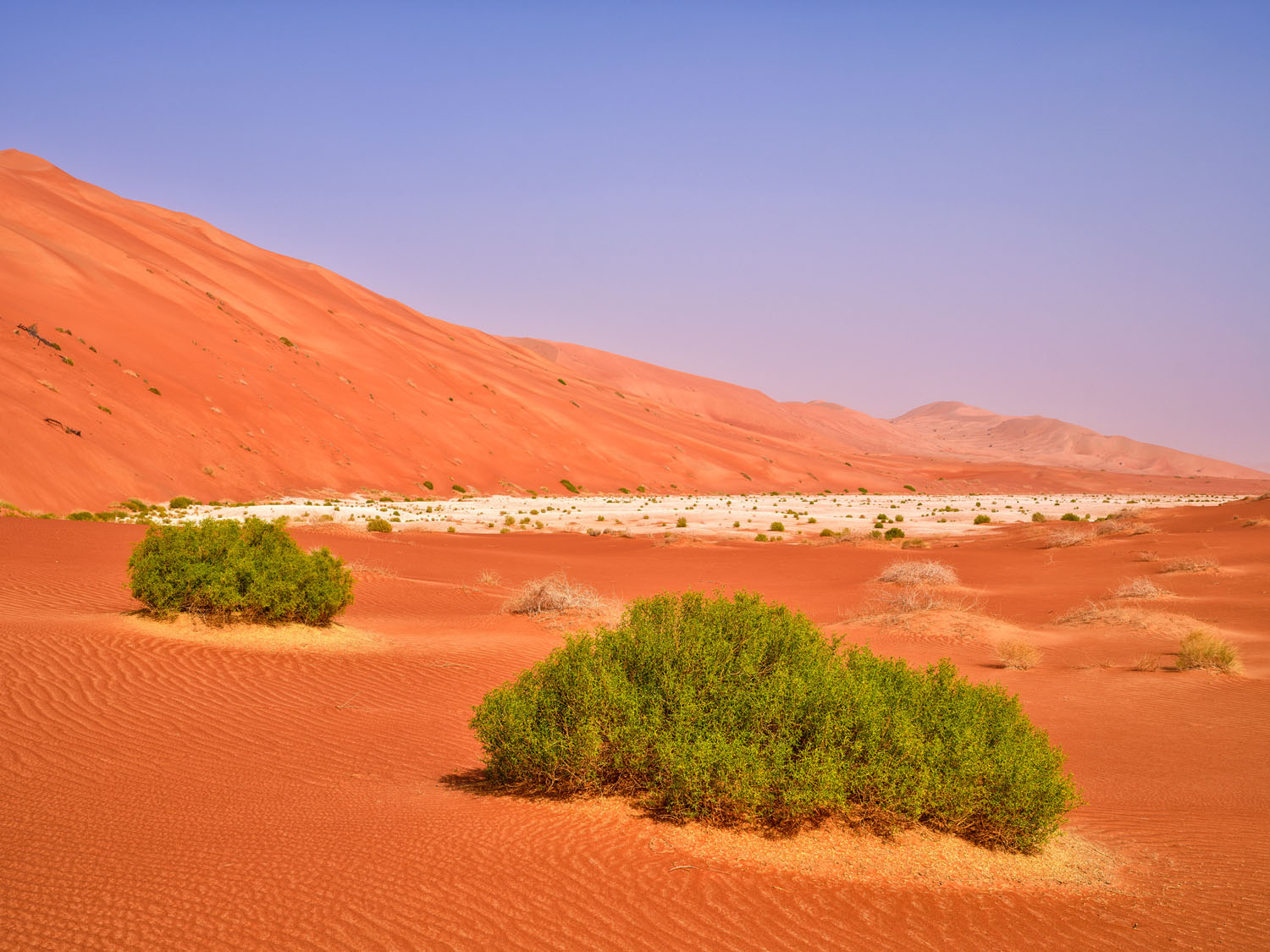
Midday doesn’t necessarily provide the best light for landscape photography – yet we give in to temptation.
We make sure that we have the sun at our backs, which doesn’t always work out…
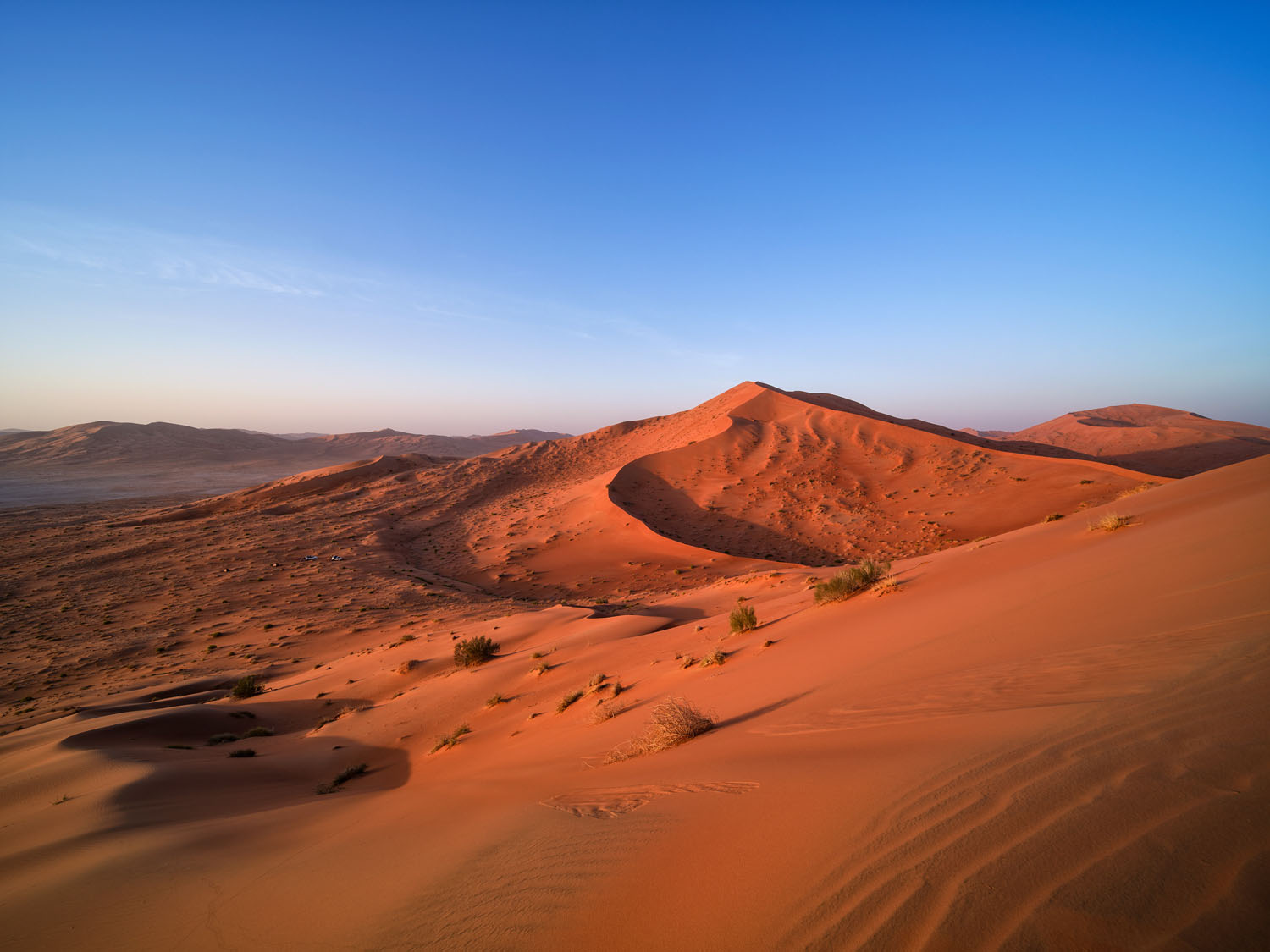

To set the scene of the vastness with our lower-lying camp, I use my LAOWA 17 mm.
To emphasize the vastness, I choose a low shooting position to integrate the structures in the sand.
RIGHT: Fuji GFX 100 . Fuji GF45-100mmF4 @45mm . f/16 . 1/4″ . ISO 160 . WB 4.860 K . Tripod

Slowly, we dive deeper and deeper into this bizarre and mystically beloved dune landscape. In the meantime, we let air out of the tires in order to increase the contact area of the tires on the sand. This increases traction and makes it easier to move forward. Our daily routine adapts more and more to the course of the sun. One hour before sunrise we get up. Depending on the location, we climb one of the surrounding dune ridges or set up our tripods in the immediate vicinity of our camp and wait. Now, between the first light of dawn and the time when the sun rises above the horizon, the color of the sand changes constantly: from pale yellow to ochre, yellowish, orange, reddish, violet… In the shadows of the dune ridges the color drowns to a deep dark black…
After breakfast, it is time to dismantle the camp and stow away the luggage. Then we set off on our way. The way? We follow the track of our GPS device, which leads us through the dune valleys. That the region is not as deserted as we think is shown by several camel herds, which are accompanied by local Bedouins looking for their food in the desert.
When we come across ‘beautiful’ dunes and depressions, we stop to take pictures. Around noon we take a break for lunch and a nap. During the afternoon hours we follow our virtual track again until we discover a photogenic dune formation, which is also suitable for a night camp. Of course, we capture the sunset as well as the following dusk photographically until the last light. Afterwards, we will have dinner at the campfire. Away from the daily stress level we enjoy the silence, philosophize about what the desert does to us as humans (emotionally) as well as to our perception. According to an Arabic proverb, “water cleanses the body – but the desert cleanses the soul”. We discuss animatedly, coming across various discrepancies…
▪ Apparent standstill with continuous change
▪ Surrounded by dry sand – drowning in emotions
▪ Absolute silence- inwardly agitated
▪ Eternity – the transience of the moment
▪ The seemingly unlimited space is divided by above (sky) and below (desert), by day and night
In total we experience six impressive days in the Rub al-Khali until we reach the edge of the desert near the oasis of Fasad. The dune valleys become significantly larger and the sand ‘only’ collects in small crescent-shaped dune fields that barely reach the waist. Now it is time to say goodbye to the desert.
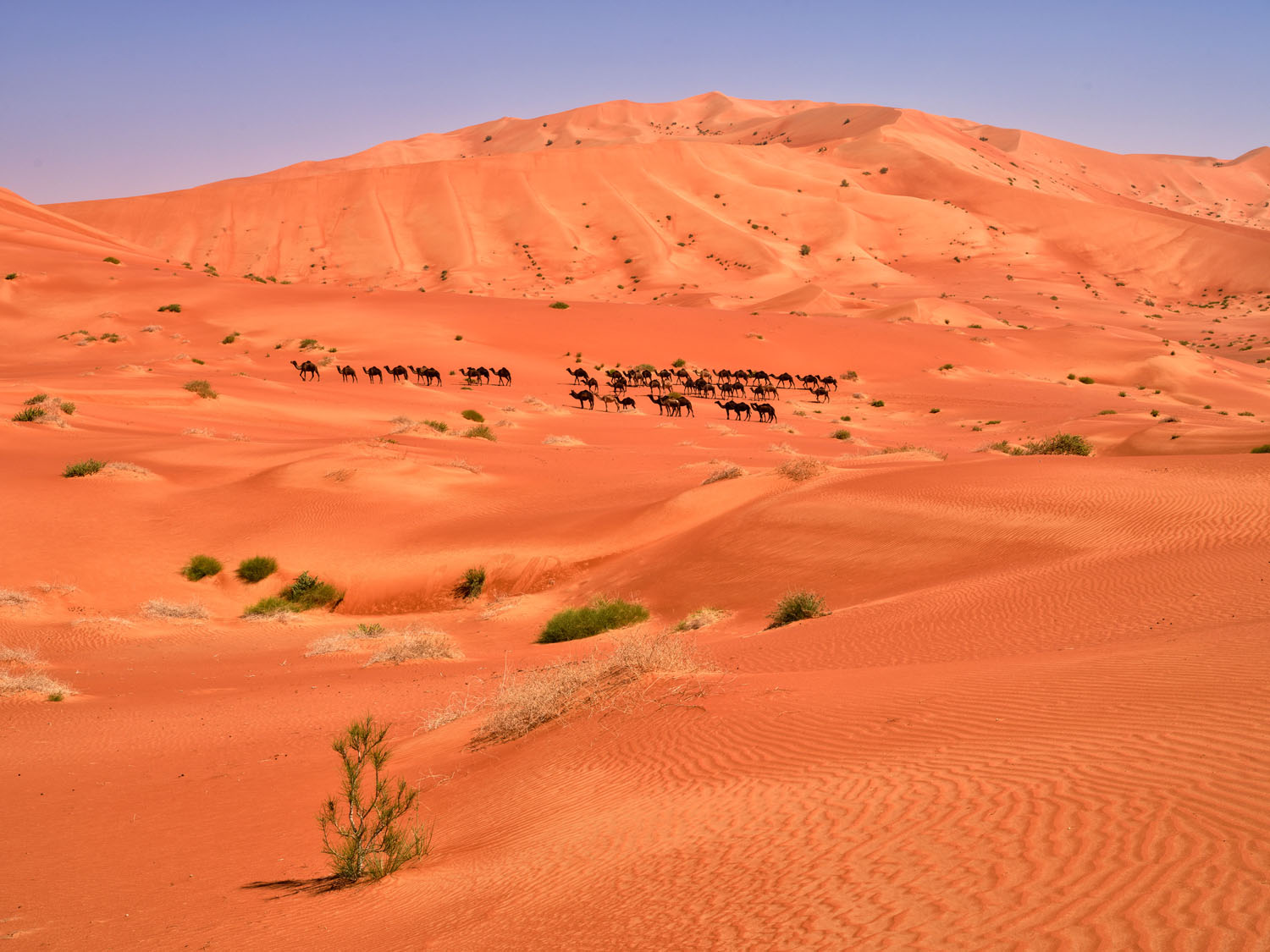
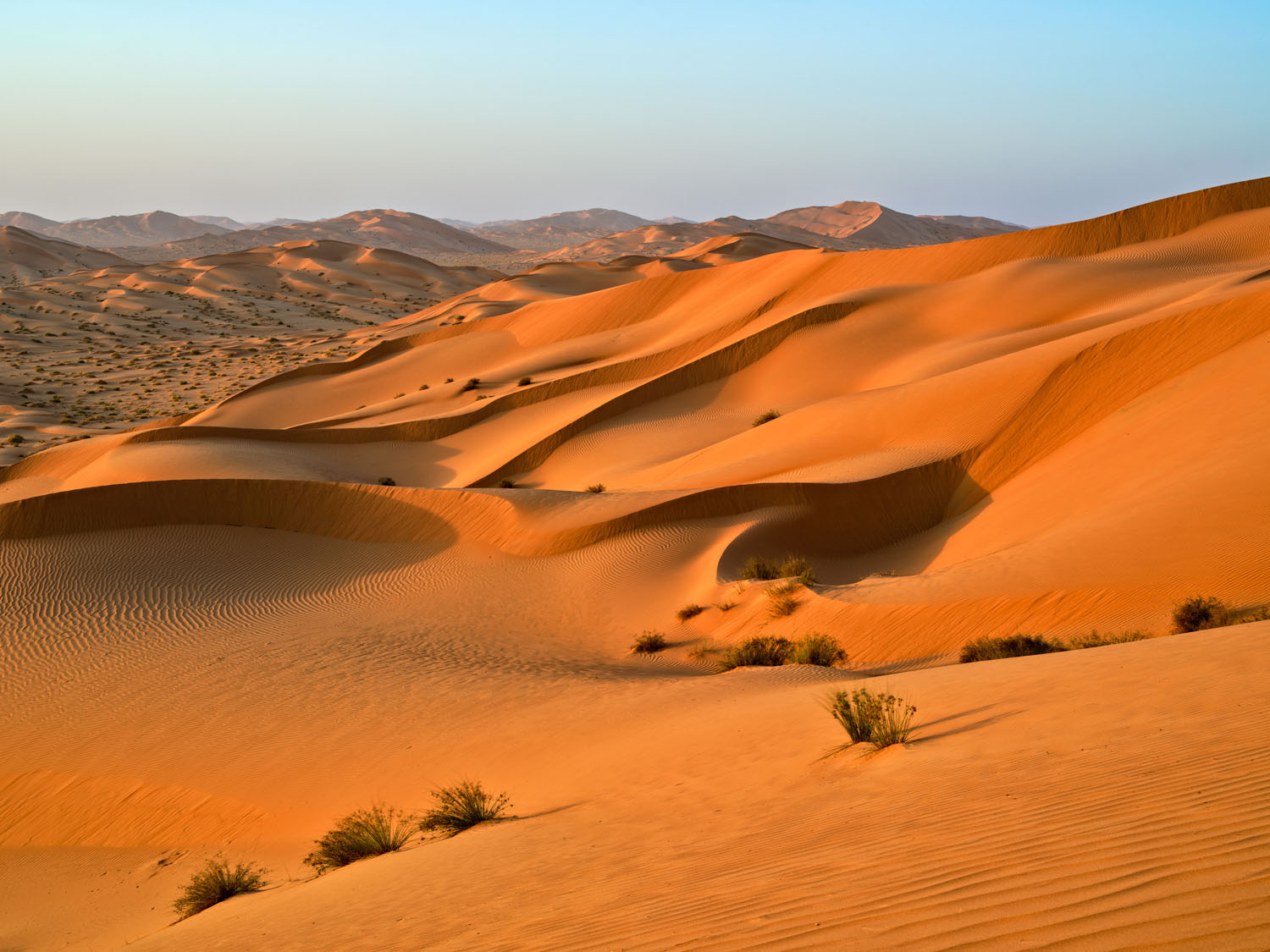
A herd of camels crosses our path somewhere in the middle of nowhere in the Rub al-Khali…
RIGHT: Fuji GFX 100 . Fuji GF45-100mmF4 @58mm . f/14 . 1/30″ . ISO 160 . WB 4.850 K . Tripod
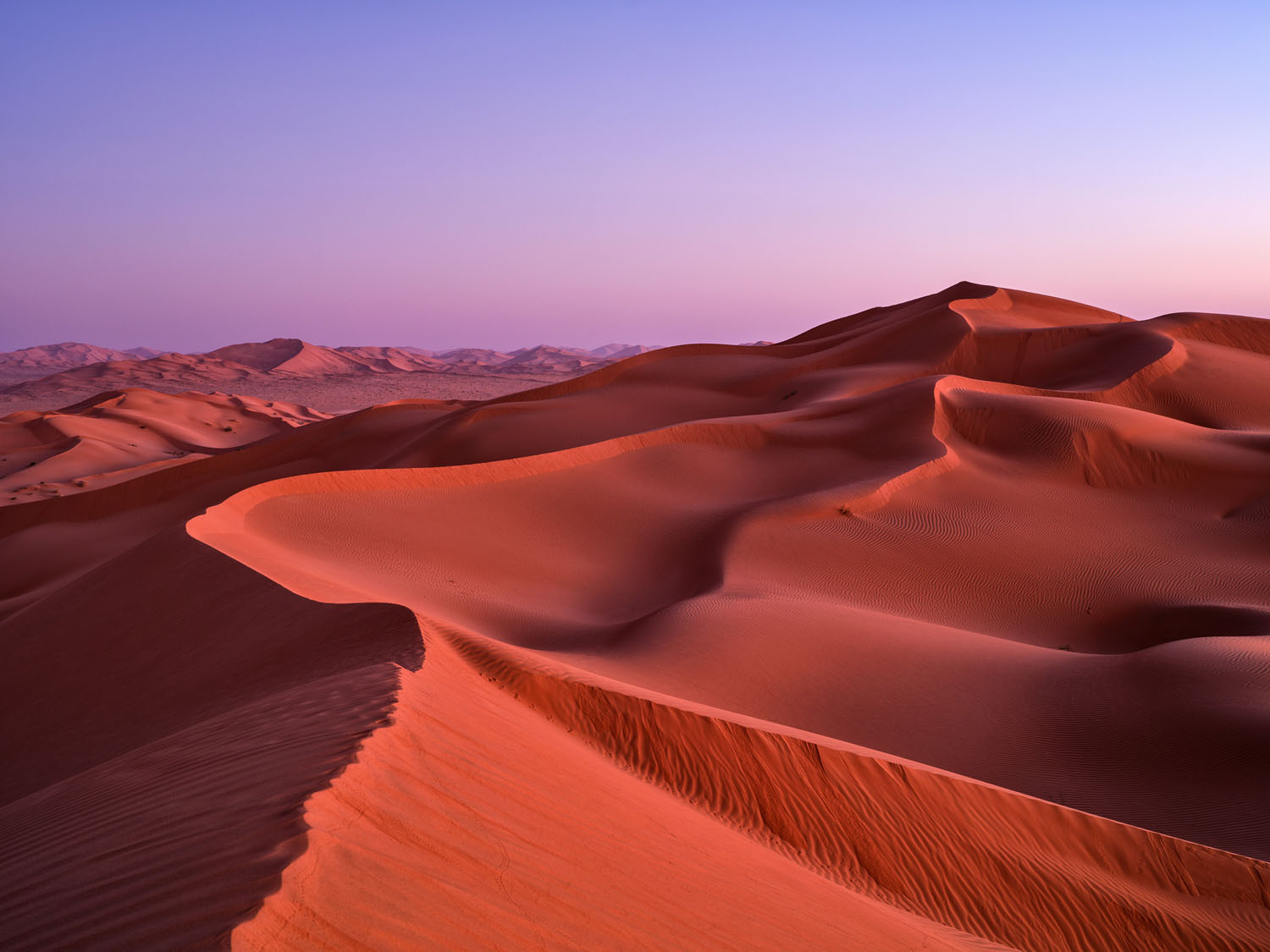
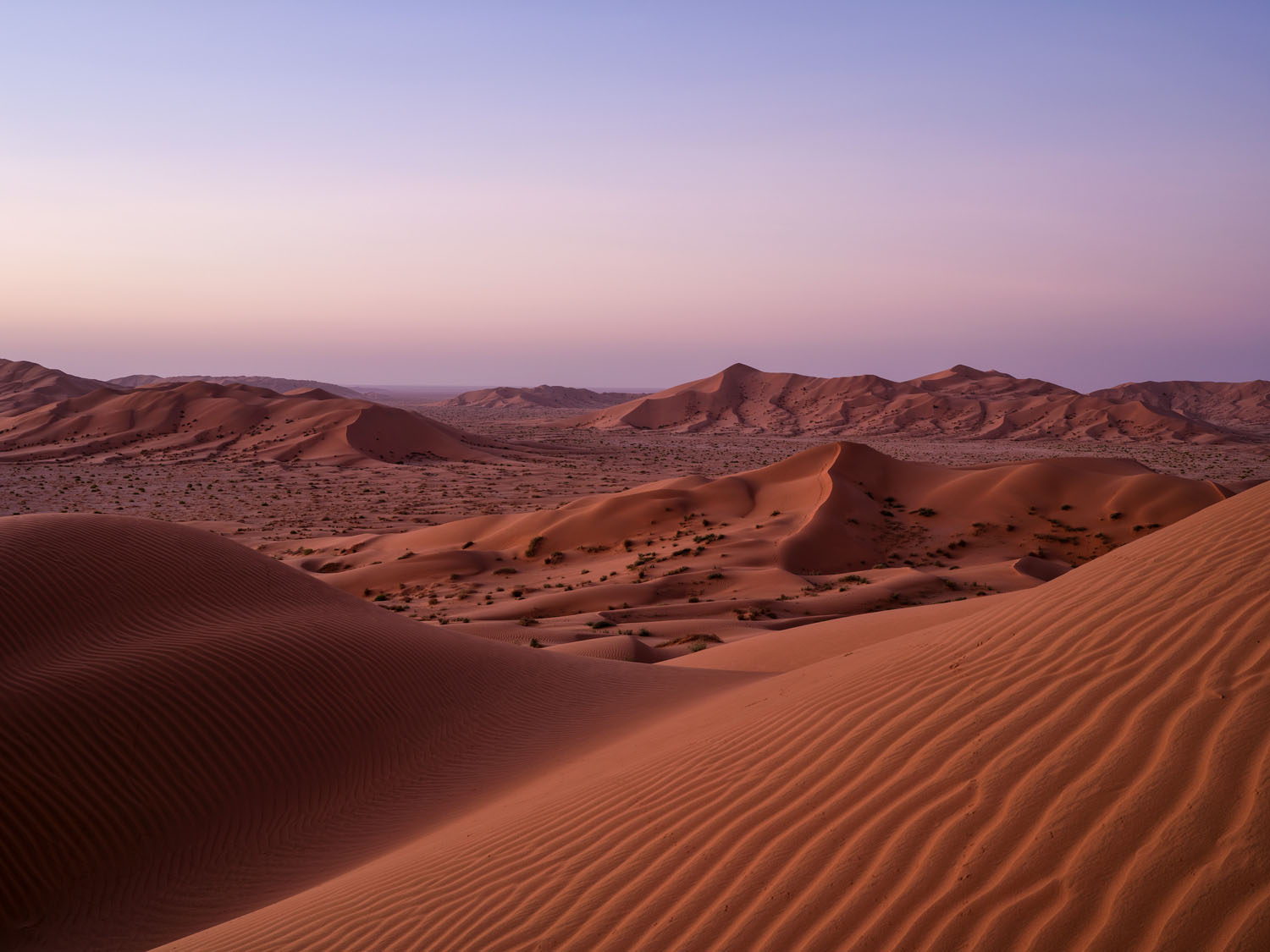
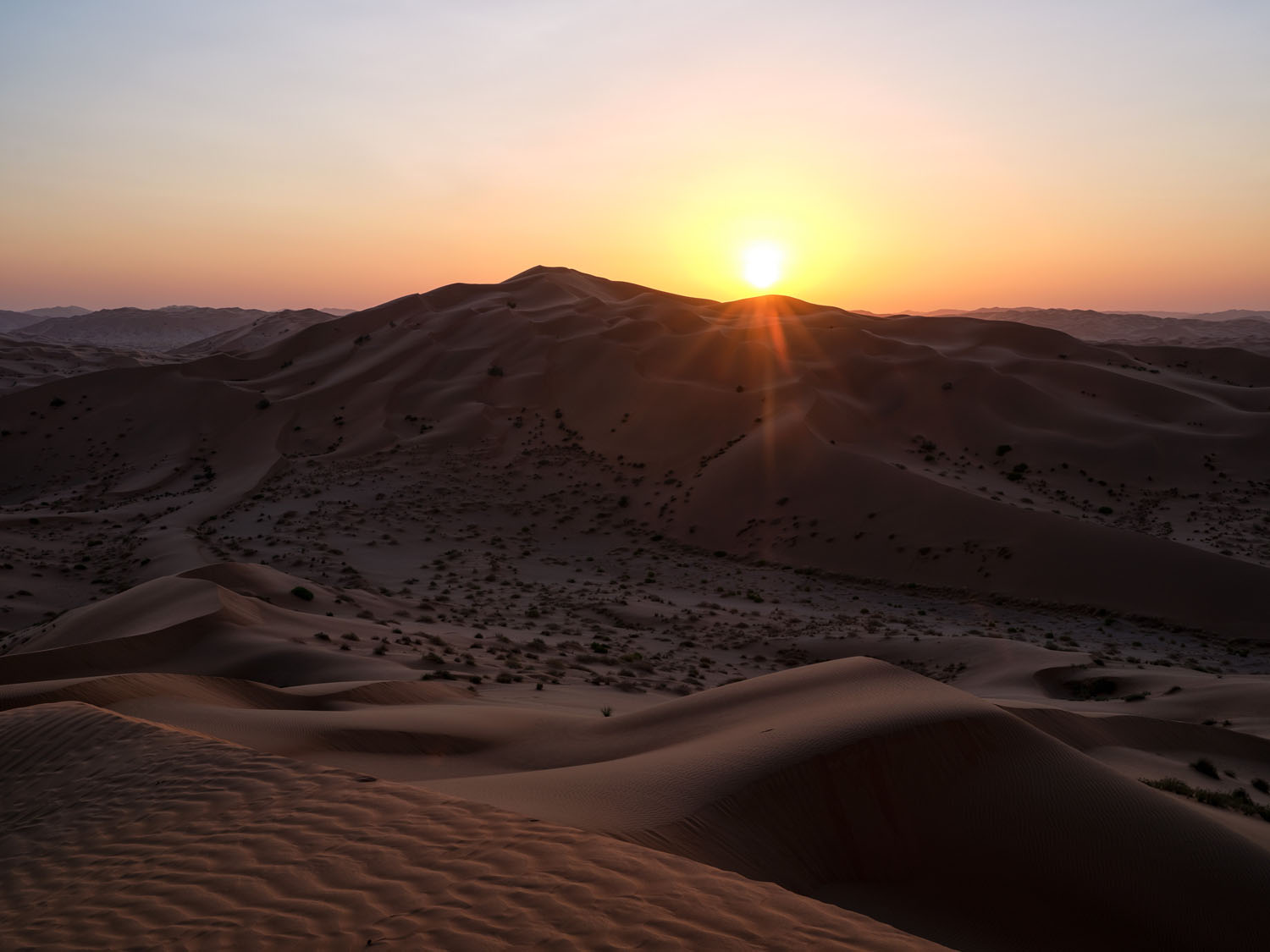
RIGHT: Fuji GFX 100 . Fuji GF45-100mmF4 @47mm . f/16 . 1/30″ . ISO 160 . WB 4.280 K . Tripod
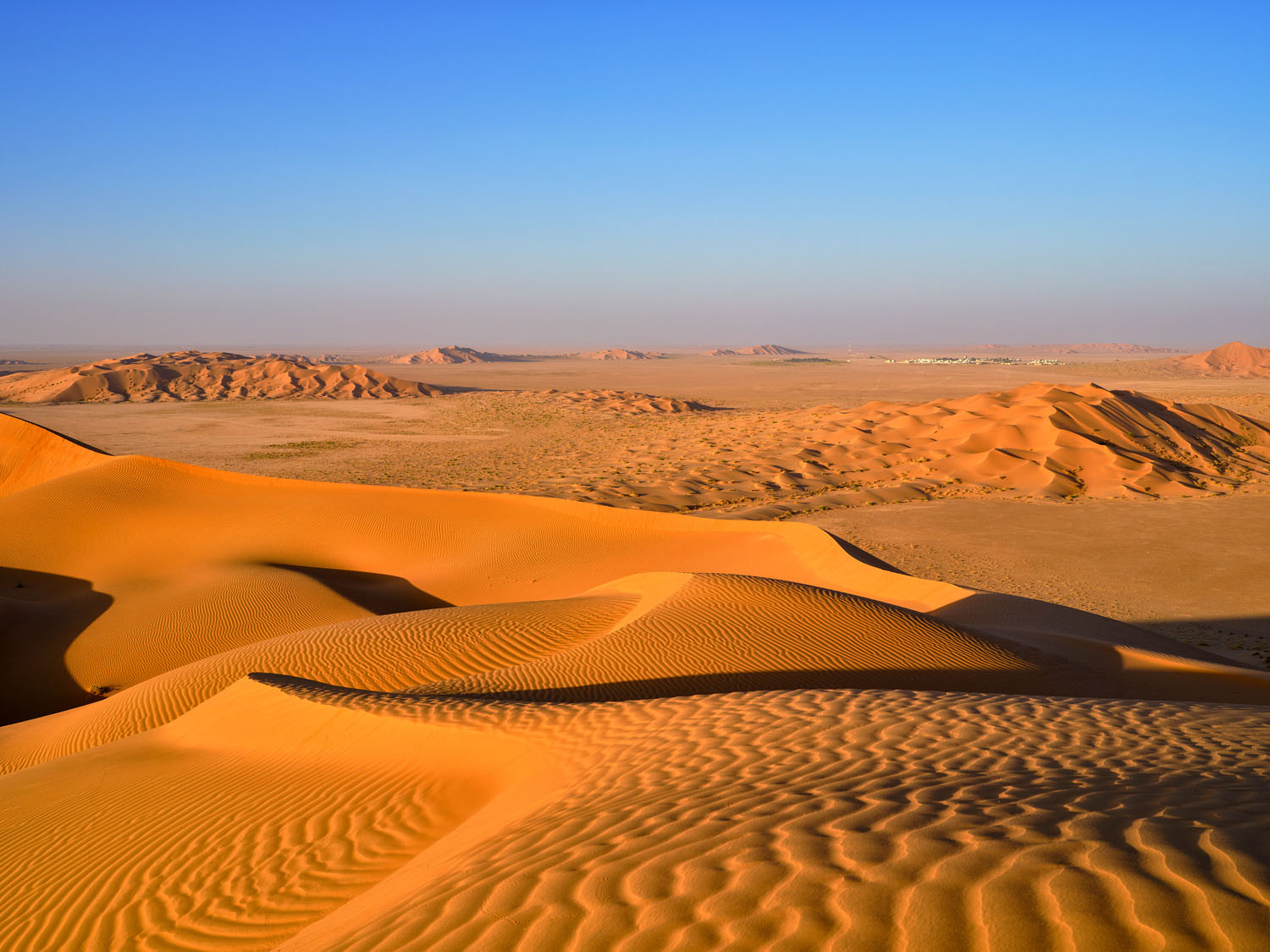
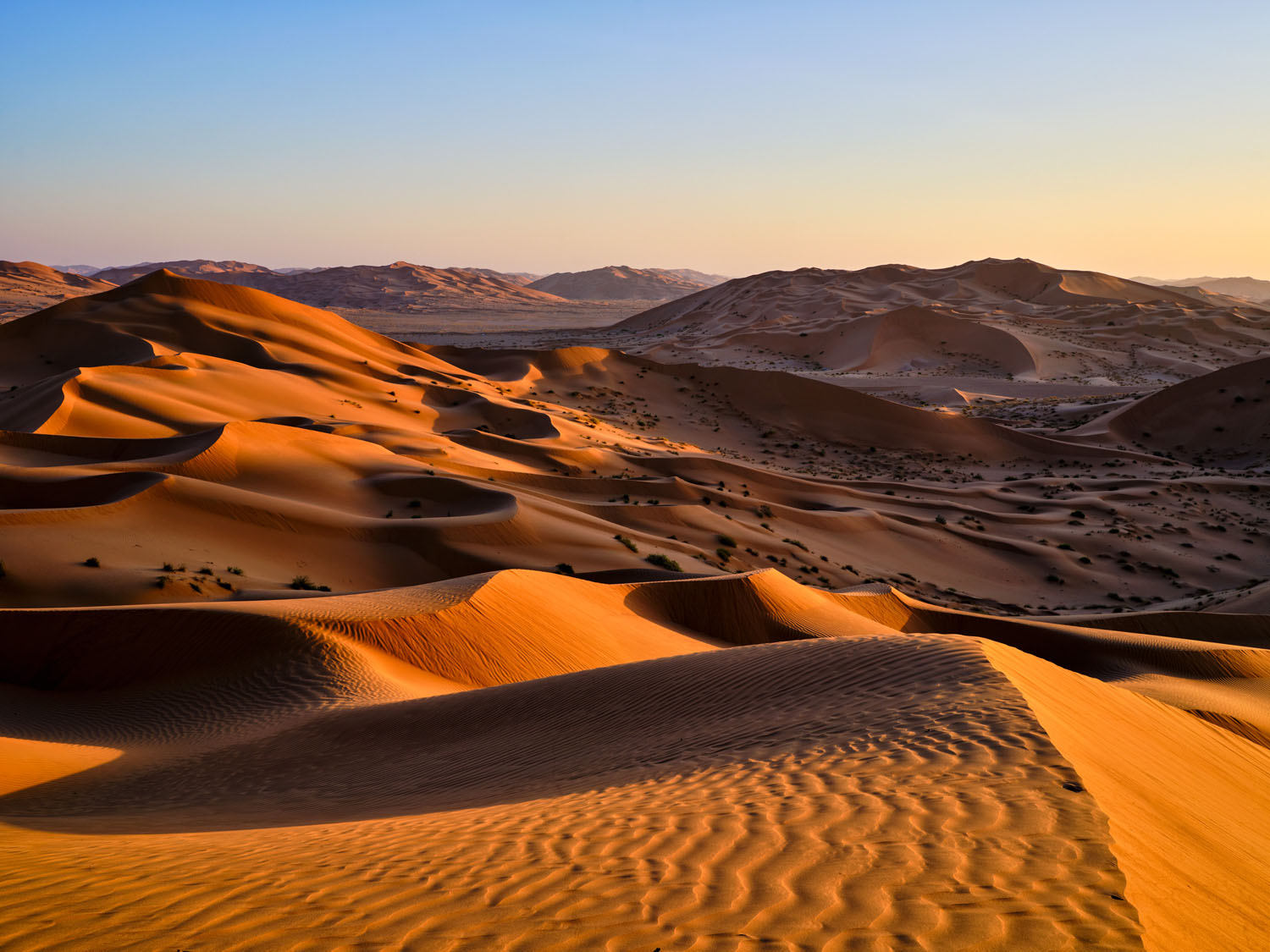
Our last sunrise at the edge of the desert. On the horizon you can already see the oasis of Fasad (on the right hand side of the picture).
Here we leave the desert and continue on the gravel road towards civilization.
RIGHT: Fuji GFX 100 . Fuji GF45-100mmF4 @47mm . f/16 . 1/30″ . ISO 160 . WB 4.280 K . Tripod
On the dusty dirt road we reach Thumrait, from where, after lunch, we cross the Dhofar Mountains with the destination of Salala. Already from the top of the pass, through the hazy layers of air, the Arabian Sea can be seen in the distance as part of the Indian Ocean. The ocean in which we wash off all the sand of the previous days in an extensive bath in the waves. The water, as well as the air temperature here, is a pleasant 27 to 29 °C. The two remaining nights we spend in the hotel with beach access, while we explore the surrounding area during the daytime.
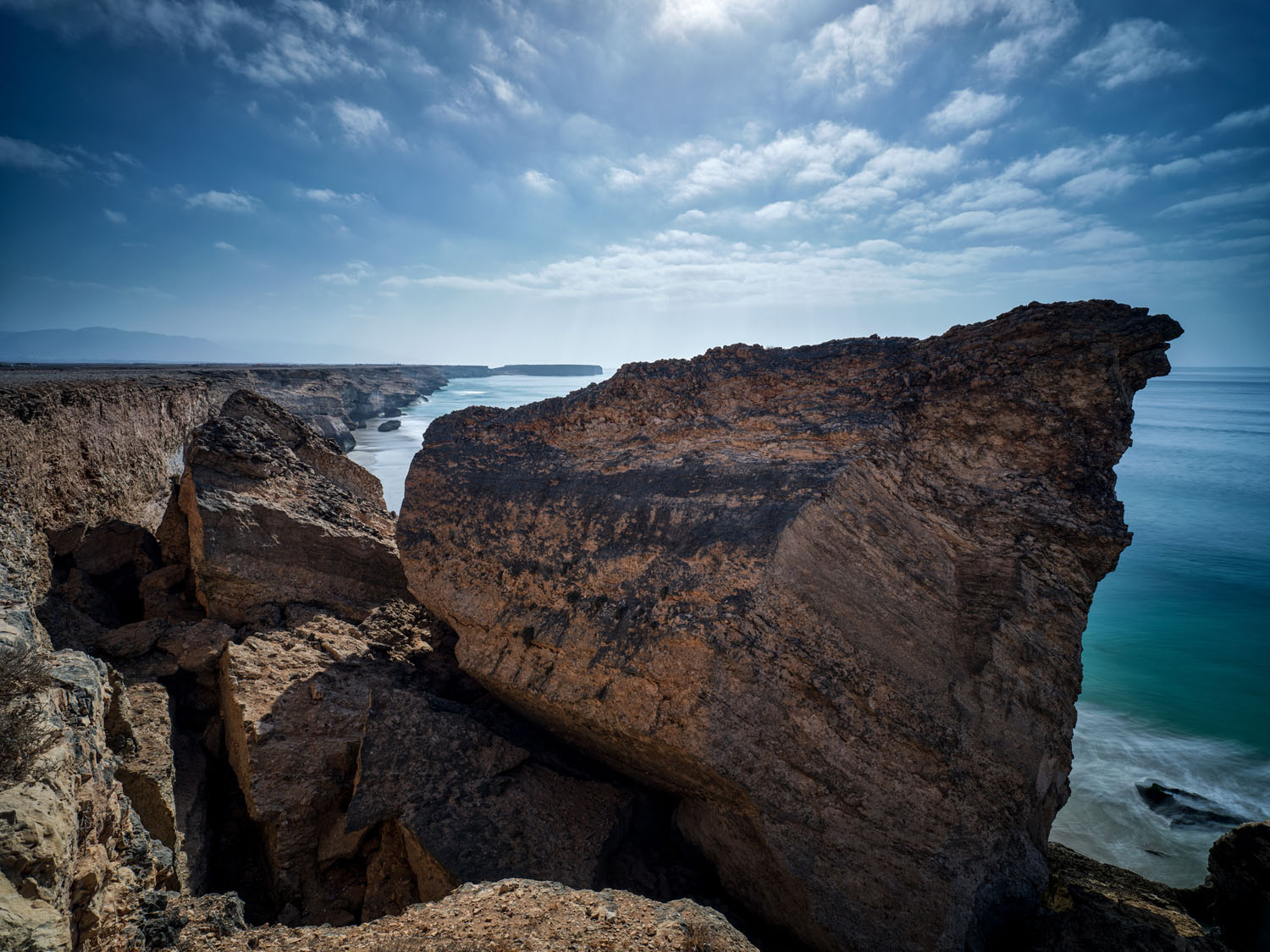
At dawn on the cliffs of Taqah, east of Salala. Even if I did without filters in the desert – here I did use different filters: The polarizing filter (CPL) to keep the reflections in check.
A gray filter (ND) to get movement into the water and a gray graduated filter (GND) to darken the too bright sky.
For the group, it is time to fly home from Salala via Muscat with Air Oman. As the photographic tour guide, it falls to me to transfer one of the two Land Cruisers to Muscat. Since I can divide my time freely, I decide to take the coastal road via harbor town Duqm and enjoy a completely different landscape than in the interior…

At the end of the photo trip I transfer the Land Cruiser back to Muscat.
A good opportunity to explore the coastal road from Salala to Duqm…

Infobox…
The Sultanate of Oman is considered a safe travel destination, which we have also perceived on site. For entry, in addition to a valid passport, a visa is required, which is applied for on-site. Special vaccinations (dengue fever, malaria, yellow fever, etc.) are not necessary. A good anti-mosquito spray, however, is extremely helpful! The population we have experienced throughout as friendly, accommodating and helpful. A country that I will definitely visit again…
I transported my photo equipment in a dust- and splash-proof photo backpack from Koenig-Photobacks (www.koenig-photobags.de). Lens changes are possible, but they should be done inside the vehicle whenever possible to avoid sand inside the camera. I used filters only on the coast. A cleaning kit to clean the front lens from time to time is helpful. A sturdy tripod, as well as a remote shutter release, are also helpful at dusk. Even though I was able to charge the batteries during the day while driving in the car, a powerbank (50,0000 mAh) as a backup is useful. On average, I needed between two and three batteries per day.
For image development in the digital darkroom, I use Capture One for RAW development. I work out the details with DxO NIK Collection. Panoramas I usually mount with Photoshop. When developing images, I deliberately avoided a consistent, uniform image look. It is important to me to use the light on location and to transport or reproduce the landscape in its original appearance.
▪ Arabian Sands
Wilfred Thesiger | ISBN: 9780141442075
▪ Along the Gulf: From Basra to Muscat
Nippa & Herbstreuth, ISBN: 9783899300703
▪ Sultan Qaboos Grand Mosque
www.sultanqaboosgrandmosque.com
▪ Royal Opera House
www.rohmuscat.org.om
▪ Nizwa Fort
https://nizwafort.om/en/
▪ www.visitoman.om
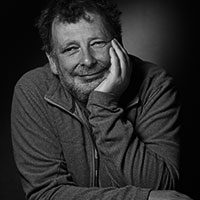
His attention is focused on the landscape in its many manifestations. His focus is on the photographic realization of landscapes as they are formed by nature and shaped by human use and culture. He regularly passes on his knowledge to interested parties in workshops and on photo trips/excursions.





Brian
April 15, 2023 @ 6:55 pm
These photos share amazing vistas and color. Thank you for including the color temperature. I am using an x-series and pretty much always use auto white balance. Were you adjusting the color temperature in post-processing? (I assume so.) Did you mask and burn to get the deep blue skies and vivid colors, or was the combined deep blue sky and red-colored sand mostly a factor of the time of day? The info on filters, tripod usage, equipment, and local requirements is also exceedingly useful. I hope to use your info to improve my shots on the next visit to the desert. We look forward to seeing more work from you here…Thank you!
Mark
April 16, 2023 @ 9:37 pm
Hej Brain // best thanks for the virtual flowers 😉 // The color temperature I find is among crucial with regard to the effect of the image! With the Fuji GFX I switched to the ‘automatic’ white balance – then in the digital darkroom the fine adjustment is done (+ / – 100 – 150 K, adjust toning if necessary) // Mask sky – combine? No! Usually I just adjust the contrasts slightly, refine depths & highlights – correct horizon – mask sensor spots if needed – done!